Class - 1
Historical Development & Salient Features of the Constitution
Before 1947, India was divided into two main entities – British India which consisted of 11 provinces, and the Princely states ruled by Indian princes under subsidiary alliance policy. The two entities merged together to form the Indian Union, but many of the legacy systems in British India is followed even now. The historical underpinnings and evolution of the Indian Constitution can be traced to many regulations and acts passed before Indian Independence.
Following Acts and reforms were introduced for the governance of India from time to time before 1858.
- The first step was taken by the British Parliament to control and regulate the affairs of the East India Company in India.
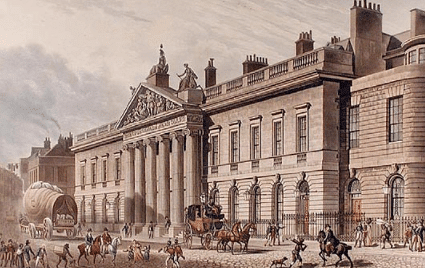 East India House, London
East India House, London
- It designated the Governor of Bengal (Fort William) as the Governor-General (of Bengal).
- Warren Hastings became the first Governor-General of Bengal.
- Executive Council of the Governor-General was established (Four members). There was no separate legislative council.
- It subordinated the Governors of Bombay and Madras to the Governor-General of Bengal.
- The Supreme Court was established at Fort William (Calcutta) as the Apex Court in 1774.
- It prohibited servants of the company from engaging in any private trade or accepting bribes from the natives.
- Court of Directors ( the governing body of the company) should report its revenue.
- Distinguished between commercial and political functions of the company.
- Court of Directors for Commercial functions and Board of Control for political affairs.
- Reduced the strength of the Governor General’s council to three members.
- Placed the Indian affairs under the direct control of the British Government.
- The companies' territories in India were called “the British possession in India”.
- Governor’s councils were established in Madras and Bombay.
- The Company’s monopoly over Indian trade terminated; Trade with India open to all British subjects.
- Governor-General (of Bengal) became the Governor-General of India.
- The first Governor-General of India was Lord William Bentick.
- This was the final step towards centralization in British India.
- Beginning of a Central legislature for India as the act also took away legislative powers of Bombay and Madras provinces.
- The Act ended the activities of the East India Company as a commercial body and it became a purely administrative body.
- The legislative and executive functions of the Governor-General’s Council were separated.
- 6 members in Central legislative council. Four out of six members were appointed by the provisional governments of Madras, Bombay, Bengal, and Agra.
- It introduced a system of open competition as the basis for the recruitment of civil servants of the Company (Indian Civil Service opened for all).
Following Acts and reforms were introduced by the British Government for the governance of India from time to time after 1858, and up to the making of the Constitution
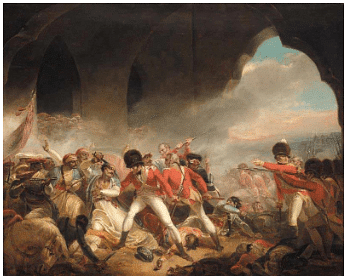 Changes brought by the Government of India Act, 1858
Changes brought by the Government of India Act, 1858
- In 1858, when the British Crown under Queen Victoria assumed sovereignty over India from the East India Company, the Parliament enacted the first statute for the governance of India under the direct rule of the British government, the Government of India Act, 1858.
The essential features of this Act were
- The Board of Control and the Court of Director was abolished and instead, the powers of the Crown were to be exercised by the Secretary of State for India, assisted by a Council of fifteen members (known as the Council of India). It was composed exclusively of people from England.
- The Governor-General was to be called Viceroy from then on.The Secretary of State, who was responsible to the British Parliament, governed India through the Governor-General, assisted by an Executive Council which consisted of high officials of the government. Thus the administration of the country was not only unitary but rigidly centralized.There was no separation of functions, and all the authority for the governance of India– civil and military, executive and legislative– was vested in the Governor-General in Council who was responsible to the Secretary of State.
- The control of the Secretary of State over the Indian administration was absolute. Subject to his ultimate responsibility to the British Parliament, he wielded the Indian administration through the Governor-General as his agent and his was the last word, whether in matters of policy or of other details.
- The entire machinery of administration was bureaucratic, totally unconcerned about public opinion in India.
(i) Indian Councils Act, 1861
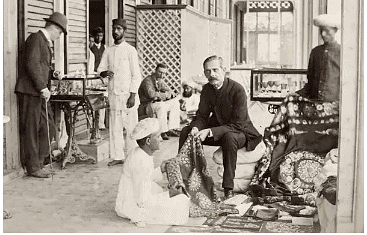 Indian Councils Art, 1861
Indian Councils Art, 1861
The improvements made by this Act were:
- The Governor-General was empowered to frame rules for the more convenient transaction of business in the Legislative Council.
- A Portfolio system was introduced in the Government of India (introduced by Lord Canning).
- The Governor-General's Executive Council, which was so long composed exclusively of officials, now included certain additional non-official members, while transacting legislative business as a Legislative Council. Some of the seats for non-officials were offered to the natives of high rank.
- The members of the Legislative Council were nominated and their functions were confined exclusively to a consideration of the legislative proposals placed before it by Governor-General. It could not, in any manner, criticize the acts of the administration or conduct of the authorities.
- The legislative powers were restored to the Presidencies of Madras and Bombay. But the laws passed by the Provincial Councils became valid only after receiving the assent of the Governor-General.
- The Governor-General was empowered, during an emergency, to issue ordinances which were to have the same authority as Acts made by the Legislative Council.
(ii) Indian Councils Act, 1892
- This act introduced two improvements upon the Act of 1861 as regards the Indian and Provincial Legislative Councils. These were-
(i) Though the majority of official members were retained, the non-official members of the Indian Legislative Council were henceforth to be nominated by the Bengal Chamber of Commerce and the Provincial Legislative Councils, while the non-official members of the Provincial Councils were to be nominated by certain local bodies such as universities, district boards, municipalities, thus introducing the principle of representation.
(ii) The Council was to have the power of discussing the annual budget to the Executive (but did not have the power to put questions).
(iii) Indian Councils Act, 1909
- Also known as Morley-Minto reforms, after the names of the then Secretary of State for India (Lord Morley) and the Viceroy (Lord Minto). The act made the first attempt to introduce a representative and popular element in the governance of India.
- The salient features of the Act are:
(i) For the first time, Indians were included in the Executive Councils of the Governor-General and Governors.
(ii) Central and Provincial Legislative Councils were enlarged but the official majority was maintained in the case of central government whereas it was gone in the provincial government.
(iii) The power of the Legislative Council was increased by this Act by giving them the opportunity of influencing the policy of the administration by moving resolutions on the Budget, and on any matter of public interest, save certain specified subjects, such as the Armed Forces, Foreign Affairs and the Indian States.
(iv) For the first time, a separate representation of the Muslim community was granted, thus sowing the seeds of separatism that eventually led to the partition of the country.
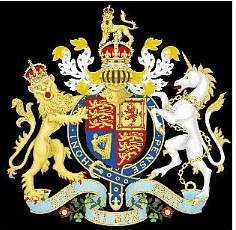 The Government of Indian Act, 1919
The Government of Indian Act, 1919
- The Indian National Congress which, established in 1885, was so long under the control of Moderates, became more active during the First World War and started its campaign for self-government (known as the 'Home Rule' movement). As a result, the British government made a declaration called the Policy of 1917.
- In this declaration, the government promised the responsible government to India as soon as possible after the War. But instead of introducing any responsible form of government in India, it came forward with its 1919 Reforms (also called Montague- Chelmsford reforms) which was formulated by the then Secretary of State for India (Mr. E.S. Montague) and the Governor-General (Lord Chelmsford).
- Dyarchy was introduced in the provinces. For the first time, Indians were given some share of power in the provincial administration, however little it was. The administration of the provinces was divided into two parts– Reserved and Transferred.
- The Reserved subjects were put directly under the British Governors while the Transferred half were administered by Indian ministers. The legislatures had official and elected members. Bicameral Central Legislature was established – the lower chamber called the Legislative
- Assembly with 144 members (104 elected's) having a non-official majority and the upper chamber called the Council of State with 60 members (34 elected). This Central Legislature continued till 1947 when power was transferred to Indian hands. The electorates were, however, arranged on a communal and sectional basis developing the Morley-Minto device further.
- However, these reforms failed to satisfy the political aspirations of India because no responsible government as promised in the 1917 declaration was granted. In fact, all powers were concentrated in the hands of the Governor-General at the Centre and the Governors in the Provinces. The Ministers worked under the pleasure of the Governors and were subject to their overriding authority. As a consequence, the political movement became militant and radical. From then started the Gandhian era in Indian politics.
- The Government of India Act, 1935 was passed in 1935 and came into operation on April 1, 1937. This Act provided for a federation for India in which the Indian State was to join British India and granted full Provincial Autonomy. The Act provided for the political separation of Burma from India. Two new provinces of Sindh and Orissa were created.
- Dyarchical system of government was established in the British Indian provinces and a similar type of government was proposed to be introduced at the Centre. The provincial part of the Constitution, which introduced autonomy in the provinces, was acceptable to the Congress to some extent, but the central part of the Act was categorically rejected.
- The Congress took part in the elections to the provincial assemblies and won a thumping majority in a number of provinces. It formed governments either independently or in cooperation with other groups in eight out of the 11 provinces. The federal part of the Act never came into operation.
- This Act was described by Jawaharlal Nehru as a "Charter of slavery". The executive was armed with wide discretionary and overriding authority. In the Centre, the native States were to join a federation and would have always sided with the British government against the nationalist forces. Except for the Hindu Mahasabha, all other parties had rejected the central part of the Act.
- However, the Congress participated in the 1937 elections and swept the polls to form governments in many provinces. But at the outbreak of the Second World War, the Congress ministries resigned on the issue of Indian participation in the War. The present Constitution is to a very large extent an adaptation of the 1935 Act to the changed conditions of free India.
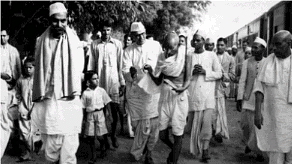 August Offer, 1940
August Offer, 1940
- The British government made an offer, known as the August Offer, in August 1940. It promised dominion status after the Second World War. The Constitution was to be framed by Indians subject to the due fulfillment of obligations which Great Britain's long connections with India had imposed upon her.
- During the War period, the Executive Council of the Governor-General was to be expanded to include the popular representatives of the people of India. Congress rejected the offer. Gandhiji started individual Satyagraha.
- Instead of reacting favorably and initiating discussions for an amicable settlement, the government of India declared an emergency all over India, and the administration of the whole country was concentrated in the hands of the Governor-General through the Governors and the Indian Civil Service. A series of new emergency ordinances were passed to meet any opposition from the popular forces in the country. Most of the national leaders were arrested and sent to jail.
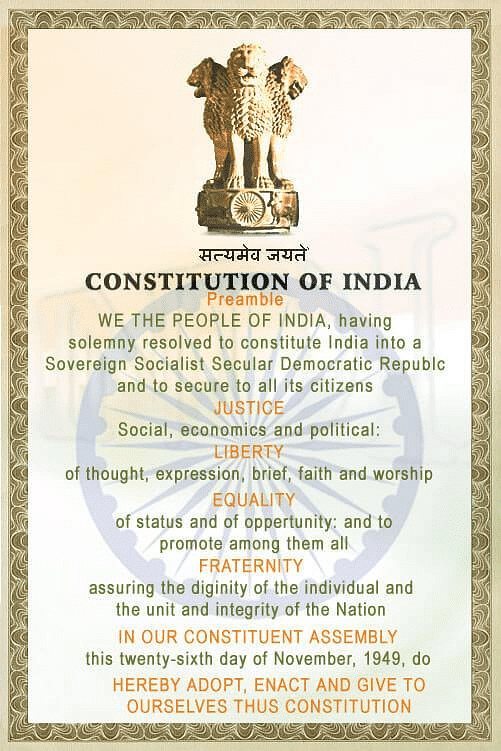 The Preamble
The Preamble
- Laws made before the Charter Act of 1833 were called Regulations and those made after are called Acts.
- Lord Warren Hastings created the office of District Collector in 1772, but judicial powers were separated from District collector later by Cornwallis.
- From the powerful authorities of unchecked executives, the Indian administration developed into a responsible government answerable to the legislature and people.
- The development of the portfolio system and budget points to the separation of power.
- Lord Mayo’s resolution on financial decentralization visualized the development of local self-government institutions in India (1870).
- 1882: Lord Ripon’s resolution was hailed as the ‘Magna Carta’ of local self-government. He is regarded as the ‘Father of local self-government in India’.
- 1921: Railway Budget was separated from the General Budget.
- From 1773 to 1858, the British tried for the centralization of power. It was from the 1861 Councils act they shifted towards devolution of power with provinces.
- 1833 Charter act was the most important activity before the act of 1909.
- Till 1947, the Government of India functioned under the provisions of the 1919 Act only. The provisions of the 1935 Act relating to Federation and Dyarchy were never implemented.
- The Executive Council provided by the 1919 Act continued to advise the Viceroy till 1947. The modern executive (Council of Ministers) owes its legacy to the executive council.
- The Legislative Council and Assembly developed into Rajyasabha and Loksabha after independence.
- Historical Development of constitution of India
- Timeline of British rule in India
- Important Acts Passed during British India and their Provinces
- Rule in India (1773-1858)
- Rule in India (1858-1947)
During 200 years of British rule in India, various acts were passed to better control this diversified large land under both Company and the Crown rules. These acts greatly influence the country’s present political structure and various constitutional provisions.
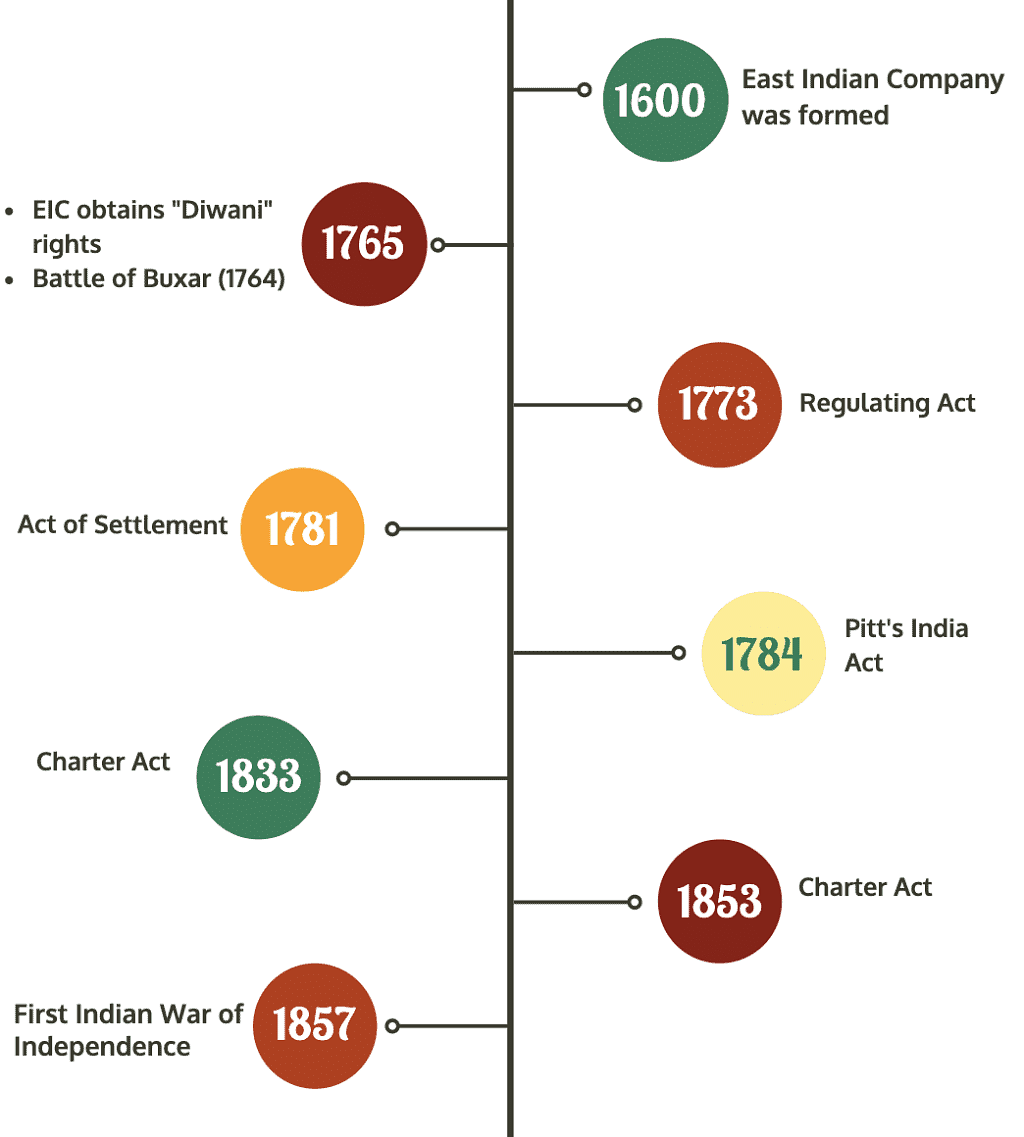 2. The Crown Rule (1858-1947)
2. The Crown Rule (1858-1947)
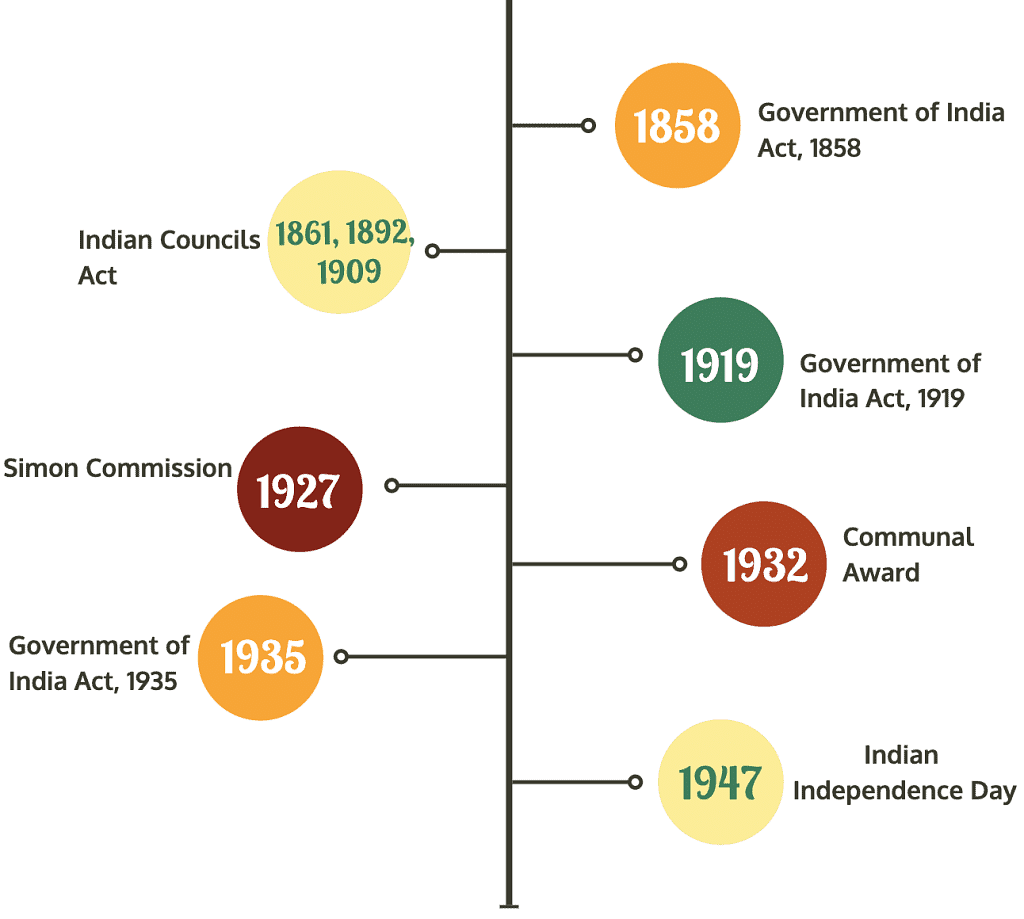
- The act was the first attempt to regularize company affairs in India.
- It laid the foundation of Central Administration in India.
- Governor of Bengal became Governor-General of Bengal (Lord Warren Hastings was the first Governor-General of Bengal).
- Created Executive Council of 4 members to assist Governor-General of Bengal.
- Made Governors of Madras and Bombay presidencies subordinate to Governor-General of Bengal.
- Provisioned for setting up the Supreme Court of Calcutta with 1 Chief justice and 3 other judges.
- Prohibited the company's servants from indulging in any private trade and accepting bribes from locals.
- Provisioned for the Company of Directors of Company to report the British Government regarding its revenue, civil and military affairs in India.
- This act was passed to amend the Regulation Act, 1773.
- Safeguarded the Governor-General and its council from the jurisdiction of the Supreme Court. Also provided immunity to the servants for their official actions.
- Exempted matters related to the Company's revenue from the Supreme Court's jurisdiction.
- Required the Supreme Court to administer the personal law of the defendant.
- Empowered the Governor-General and its Council to frame regulations regarding Provincial Courts and Councils.
Features of the Act
- Established a system of Double Government. Provided for Court of Director to manage its commercial affairs while a new body called Board of Control managed its political affairs.
- Empowered the Board of Control to supervise and direct civil and military operations and revenues of India's British possessions.
Significance of the Act
- First time acknowledged Indian Territory under control of the company as India's British possessions.
- The British government became the Supreme Controller of the Company’s affairs and administration in India.
- This Act continued the company’s rule over the British territories in India.
- It continued the company’s trade monopoly in India for another 20 years.
- The Act established that “acquisition of sovereignty by the Crown subjects is on behalf of the Crown and not in its own right,” which clearly stated that its political functions were on behalf of the British government.
- The company’s dividends were allowed to be raised to 10%.
- The Governor-General was given more powers. He could override his council’s decision under certain circumstances.
- He was also given authority over the governors of Madras and Bombay.
- When the Governor-General was present in Madras or Bombay, he would supersede Madras and Bombay's governors.
- In the Governor-General’s absence from Bengal, he could appoint a Vice President from among the civilian members of his Council.
- The composition of the Board of Control changed. It was to have a President and two junior members, who were not necessarily members of the Privy Council.
- The staff's salaries and the Board of Control were also now charged to the company.
- After all expenses, the company had to pay the British government Rs.5 Lakhs from the Indian revenue annually.
- Senior company officials were barred from leaving India without permission. If they did so, it would be considered as a resignation.
- The company was granted the authority to grant licenses to individuals and company employees to trade in India. This was known as ‘privilege’ or ‘country trade’. This led to shipments of opium to China.
- This Act separated the revenue administration and its judiciary functions, leading to Maal Adalats (revenue courts).
- Abolished India's trade monopoly except for trade in tea and trade with China.
- Allowed Christian missionaries to come to India and start their religious awakening in India.
- Authorized Local Governments in India to levy taxes on the people of India.
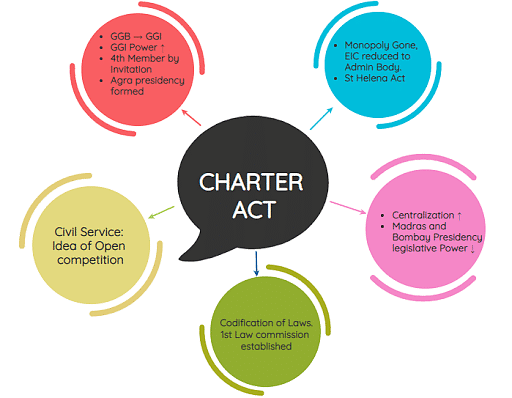
- Made Governor-General of Bengal as the Governor-General of India and vested all civil and military powers (Lord William Bentinck became the first Governor-General of India).
- Empowered Governor-General of India with the exclusive legislative powers of entire British India.
- The Company became a purely administrative body.
- Separated legislative and executive functions of the Governor-General’s Council.
 Governor-General's Council
Governor-General's Council - Provided for a separate 6 members Indian Legislative Council to function as mini parliament.
- Provisioned for open competition system for Indian Civil Services for Indians also.
- Introduced local representation in the Indian (Central) Legislative Council. (out of 6 members, 4 to be appointed by the local governments of Madras, Bombay, Bengal, and Agra)
 Government of India Act, 1858
Government of India Act, 1858
- Post-1857 revolt British Government took control over India's entire territory under Company rule. The act is also known as the Act of Good Government of India.
Features of the Act
- Changed the post of Governor-General of India to Viceroy of India and made him the representative of India's British Crown (Lord Canning was the first Viceroy of India).
- Abolished the Board of Control and Court of Directors.
- Created office of Secretary of State for India, vested with complete authority and control over Indian administration.
- Created a 15 member Council of India to assist the Secretary of State for India.
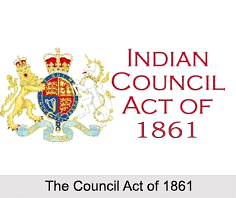
Features of the Act
- Empowered the Viceroy to nominate some Indians as the non-official members under his expanded council (Lord Canning nominated 3 Indians: the Raja of Benaras, the Maharaja of Patiala, and Sir Dinkar Rao).
- Decentralized legislative powers by empowering the Bombay and Madras Presidencies.
- Provided for establishing new legislative councils for Bengal, North-Western Provinces, and Punjab. The act established the Portfolio system in Indian administration. It empowered the Viceroy to make rules and orders for the Council's better functioning and made members of the council in-charge and authorized to issue orders regarding one or more government departments allocated to them.
- Empowered the Viceroy of India to issue ordinances in an emergency without the legislative council's concurrence and with a validity of 6 months.
- Increased number of non-official members in the Central and Provincial legislative councils.
- Empowered the legislative councils by discussing budget and addressing questions to the executive.
- Provided for the nomination of some non-official members of the:
(i) Central Legislative Council by the viceroy on the Provincial Legislative Councils' recommendation and the Bengal Chamber of Commerce, and that of the Provincial Legislative Councils by the Governors on the district board's recommendation, municipalities, universities, trade associations, zamindars, and chambers.
- Also known as Morley-Minto Reforms.
 Morley-Minto Reforms
Morley-Minto Reforms - The number of members in the Central Legislative Council was increased from 16 to 60, and the number of members in the Provincial Legislative Council was also increased but not uniformly.
- Empowered the members of legislative councils at both levels to ask supplementary questions, move resolutions on the budget, etc.
- Provided for the association of Indians with the executive councils of the Viceroy and Governors (Satyendra Prasad Sinha was the first Indian to join the Viceroy’s executive council as the Law member).
- Introduced system of communal representation for Muslims and separate electorate for them.
Features of the Act
- Also known as the Montagu-Chelmsford Reforms.
- Separated Central and Provincial subjects.
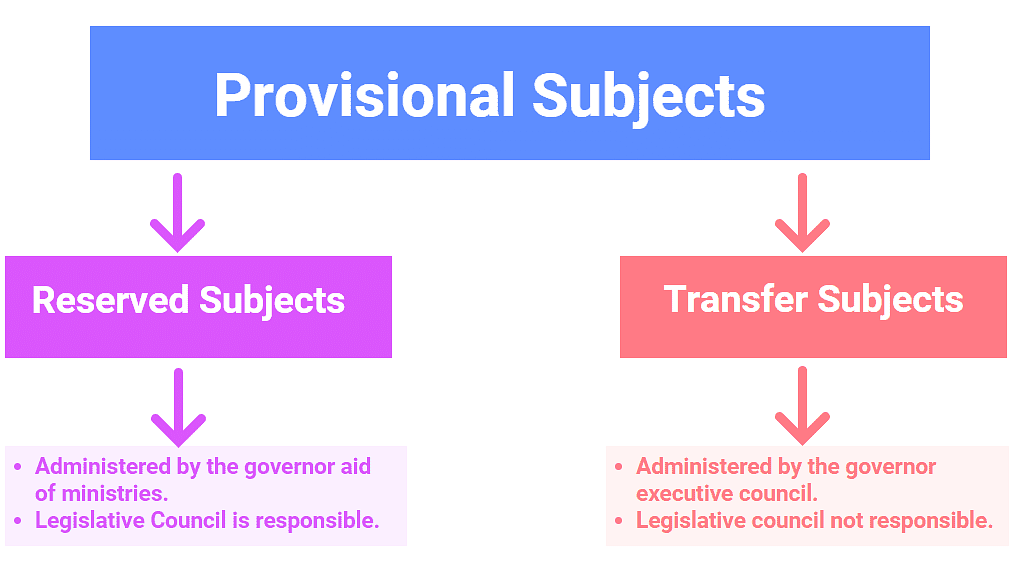 Division of Provisional Subjects
Division of Provisional Subjects
- Provincial subjects were further divided into transferred subjects and reserved subjects. Transferred subjects were to be governed by the Governor with ministers of the legislative council and Governor's reserved subjects with his executive council.
- Introduced bicameralism and direct elections in the country.
- Provisioned for 3 out of 6 members of the Viceroy’s executive council were to be Indian. Provided for separate electorates for Sikhs, Indian Christians, Anglo-Indians, and Europeans.
- Granted franchise to a limited number of people based on property, tax or education.
- The created new office of High Commissioner for India in London.
- Provided for setting up a Central Service Commission for recruiting civil servants.
- Separated provincial budgets from the Central budget and authorized the provincial legislatures to enact their budgets.
Significance of the Act
- This was intended towards a responsible government in British India; the legislature's elected members' role was mere advisory. Viceroy retained control of the central government.
- Later with the passage of the Rowlatt Act, the government suppressed the voices of Indians as it empowered the Government to imprison any person without trial and conviction in a court of law.
- Simon Commission was then appointed in 1927, which was opposed greatly by Indians.
Events leading to Act
- Incorporating the recommendations of the Simon Commission (1930).
- Civil Disobedience Movement (1930).
- Recommendations of Round Table Conferences (1930, 31 and 32).
- Gandhi-Irwin Pact.
- Poona Pact between Gandhi Ji and B.R. Ambedkar (1932).
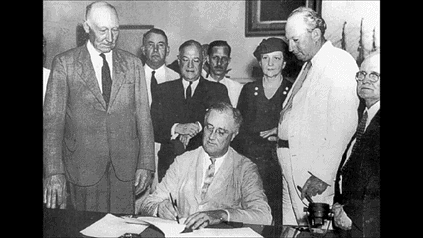
Features of the Act
- Provided for establishing an All India Federation consisting of provinces and princely states.
- Divided powers into three lists: Federal list (for Centre, with 59 items), Provincial list (for Provinces, with 54 items) and the Concurrent list (for both, with 36 items). The Viceroy was empowered with all the residuary powers.
- Abolished dyarchy in the provinces and introduced provincial autonomy. It introduced responsible Governments in provinces where the Governor needed to work on ministers' advice responsible to the provincial legislature.
- Provided for the adoption of dyarchy at the Centre. Federal subjects were divided into transferred subjects and reserved subjects.
- Introduced bicameralism in 6 out of 11 provinces (Bengal, Bombay, Madras, Bihar, Assam and the United Provinces).
- Divided Federal Budget in 80 per cent non-votable part could not be discussed or amended in the legislature. The remaining 20 per cent of the whole budget could be discussed or amended in the Federal Assembly.
- Provisioned for separate electorates for depressed classes (Scheduled Castes), women and labour. It extended franchise, and about 10 per cent of the total population got voting rights.
- Abolished the Council of India.
- Established Reserve Bank of India to control the country's currency and credit.
- Established Federal Public Service Commission, Provincial Public Service Commission and Joint Public Service Commission.
- Provided for setting up a Federal Court.
Significance of the Act
- Reflected the ambiguity of British commitment to dominion status for India.
- Discussed nothing about the citizens’ rights.
- There was no major impact on the Governor-General's powers and that of Governors in the provinces.
- Communal electorate further divided Indian society.
- The Constitution so created was rigid, and the power to amend was reserved with the British parliament.
Based on the Muslim league's demands for a separate nation for Muslims, the then Viceroy of India, Lord Mountbatten, pot forth the partition plan, known as the Mountbatten Plan. Both Congress and the Muslim League accepted the plan. The Indian Independence Act of 1947 gave immediate effect to the plan.
 Features of the Act
Features of the Act
- Ended British rule in India and declared India to be an independent and sovereign state from August 15, 1947.
- It provisioned for India and Pakistan's partition as two independent dominions with the right to secede from the British Commonwealth.
- It empowered the Constituent Assemblies of the two nations to frame and adopt any constitution of their respective nations and repeal any British Parliament act, including the Independence Act itself.
- It abolished the office of Secretary of State for India and transferred his powers to the Secretary of State for Commonwealth Affairs.
- It deprived the British Monarch of his right to veto bills or ask for a reservation of certain bills for his approval.
- It designated the Governor-General of India and provincial governors as constitutional (nominal) heads of the states.
- It dropped Emperor of India's title from the King of England's royal titles.
- It discontinued the appointment to Civil Services and the Secretary of State of India's posts and reservation of posts.
- Crown ceased to be the Source of Authority.
Significance of the Act
- As per the provision under the Act, India became an independent nation on 15th August 1947, and the British ruled India came to an end.
- Lord Mountbatten became the last Governor-General of British India and the first Governor-General of India's new dominion.
- J.L. Nehru became the first Prime Minister of the Country.
- The Constituent Assembly of India, constituted in 1946, became the Parliament of Independent India.
- As per the act's provision, the princely states were free to join any of the two dominions or set themselves free, which led to a huge unification of the country and curb the seceding tendencies.
Before 1947, India was divided into two main entities – British India which consisted of 11 provinces, and the Princely states ruled by Indian princes under subsidiary alliance policy. The two entities merged together to form the Indian Union, but many of the legacy systems in British India is followed even now.
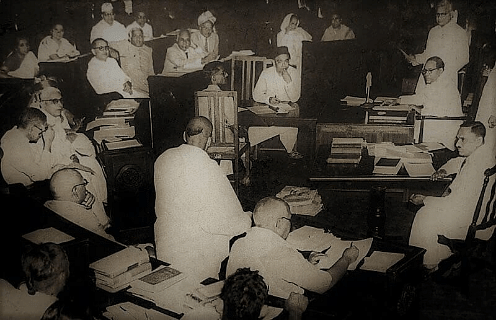 The historical underpinnings and evolution of the Indian Constitution can be traced to many regulations and acts passed before Indian Independence.
The historical underpinnings and evolution of the Indian Constitution can be traced to many regulations and acts passed before Indian Independence.
Indian democracy is a Parliamentary form of democracy where the executive is responsible to the Parliament. The Parliament has two houses – Loksabha and Rajyasabha. Also, the type of governance is Federal, i.e. there is separate executive and legislature at Center and States. We also have self-governance at local government levels. All these systems owe their legacy to the British administration. Let us see the historical background of the Indian Constitution and its development over the years.
➢ Regulating Act of 1773
- The first step was taken by the British Parliament to control and regulate the affairs of the East India Company in India.
- It designated the Governor of Bengal (Fort William) as the Governor-General (of Bengal).
- Warren Hastings became the first Governor-General of Bengal.
- Executive Council of the Governor-General was established (Four members). There was no separate legislative council.
- It subordinated the Governors of Bombay and Madras to the Governor-General of Bengal.
- The Supreme Court was established at Fort William (Calcutta) as the Apex Court in 1774.
- It prohibited servants of the company from engaging in any private trade or accepting bribes from the natives.
- Court of Directors ( the governing body of the company) should report its revenue.
➢ Amending Act 1781
- Supreme Court to have jurisdiction over all the citizens of Calcutta and to take into consideration religious & social customs.
- For cases involving below £ 5000, the Governor-General in Council was the highest court of appeal.
➢ Pitts India Act, 1784
- Distinguished between commercial and political functions of the company.
- Court of Directors for Commercial functions and Board of Control for political affairs.
- Reduced the strength of the Governor General’s council to three members.
- Placed the Indian affairs under the direct control of the British Government.
- The companies' territories in India were called “the British possession in India”.
- Governor’s councils were established in Madras and Bombay.
➢ The Act of 1786
- Governor-General was made commander in chief and was given the power to override his council in extraordinary cases.
➢ The Charter Act of 1793
- The power of the Governor-General to override his Council was extended to all future Governors-general.
- During the absence of Governor-General from Bengal, he was to appoint a vice President from civilian members of the council to act for him.
- All the members in the future to be paid salaries out of the Indian revenue.
- All laws were translated into Indian languages.
➢ Charter Act of 1813
- The monopoly of trade with India was ended but the monopoly of tea trade with China was allowed.
➢ Charter Act of 1833
- The monopoly of tea trade with China was abolished. The company was only to have political functions.
- President of Board of Council became the Minister for Indian affairs.
- A law member without power to vote was added to the Executive Council of Governor-general (Lord Macvallay was 1st law member).
- Competition exams were introduced for recruitment to the coveted services.
- Rs.1 lakh to be spent on education in India.
- It made the Governor-General of Bengal as the Governor-General of India (Lord William Bentinck was the first Governor-General of India).
➢ Charter Act of 1853
- The legislative and executive functions of the Governor-General’s Council were separated.
- 6 members in Central legislative council. Four out of six members were appointed by the provisional governments of Madras, Bombay, Bengal, and Agra.
- It introduced a system of open competition as the basis for the recruitment of civil servants of the Company (Indian Civil Service opened for all).
- The British Crown assumed sovereignty over India from the East India Company in 1857 and the British Parliament enacted the first statute for the government of India under the direct rule of the British government.
➢ Government of India Act, 1858
- The rule of the Company was replaced by the rule of the Crown in India.
- The powers of the British Crown were to be exercised by the Secretary of State for India
- He was assisted by the Council of India, having 15 members
- He was vested with complete authority and control over the Indian administration through the Viceroy as his agent
- The Governor-General was made the Viceroy of India.
- Lord Canning was the first Viceroy of India.
- Abolished Board of Control and Court of Directors.
➢ Government of India Act 1861
- It introduced for the first time Indian representation in the institutions like Viceroy’s executive+legislative council (non-official). 3 Indians entered the Legislative council.
- Legislative councils were established in the Center and provinces.
- It provided that the Viceroy’s Executive Council should have some Indians as the non-official members while transacting the legislative businesses.
- It accorded statutory recognition to the portfolio system.
- Initiated the process of decentralization by restoring the legislative powers to the Bombay and the Madras Provinces.
➢ Indian Council Act, 1892
- It introduced the principle of the election but in an indirect manner.
- Though the majority of official members were retained, the nonofficial members of the Indian Constitution council were to be nominated by the Bengal Chamber of commerce and the Provincial Legislative councils while the non - official members of the Provincial Councils were to be nominated by certain local bodies such as universities, district boards, municipalities.
- The councils were to have the powers of discussing the annual statement of revenue and expenditure and of addressing questions to the Executive.
➢ The Minto-Morley Reforms and The Indian Council Act, 1909
- Direct elections to legislative councils; first attempt at introducing a representative and popular element.
- It changed the name of the Central Legislative Council to the Imperial Legislative Council.
- The member of the Central Legislative Council was increased to 60 from 16.
- Introduced a system of communal representation for Muslims by accepting the concept of ‘separate electorate’.
- Indians for the first time in Viceroy's executive council. (Satyendra Prasad Sinha, as the law member)
- This Act is also known as the Montague-Chelmsford Reforms.
- The Central subjects were demarcated and separated from those of the Provincial subjects.
- The scheme of dual governance, ‘Dyarchy’, was introduced in the Provincial subjects.
- Under the dyarchy system, the provincial subjects were divided into two parts – transferred and reserved. On reserved subjects, Governor was not responsible to the Legislative council.
- The Act introduced, for the first time, bicameralism at the center.
- Legislative Assembly with 140 members and Legislative council with 60 members.
- Direct elections.
- The Act also required that the three of the six members of the Viceroy’s Executive Council (other than Commander-in-Chief) were to be Indians.
- Provided for the establishment of the Public Service Commission.
- The Act provided for the establishment of an All-India Federation consisting of the Provinces and the Princely States as units, though the envisaged federation never came into being.
- Three Lists: The Act divided the powers between the Centre and the units into items of three lists, namely the Federal List, the Provincial List, and the Concurrent List.
- The Federal List for the Centre consisted of 59 items, the Provincial List for the provinces consisted of 54 items, and the Concurrent List for both consisted of 36 items
- The residuary powers were vested with the Governor-General.
- The Act abolished the Dyarchy in the Provinces and introduced ‘Provincial Autonomy’.
- It provided for the adoption of Dyarchy at the Centre.
- Introduced bicameralism in 6 out of 11 Provinces.
- These six Provinces were Assam, Bengal, Bombay, Bihar, Madras, and the United Province.
- Provided for the establishment of Federal Court.
- Abolished the Council of India.
- Abolition of the Sovereignty and Responsibility of the British Parliament.
- The Crown no longer be a source of authority
- The Governor-general and provincial Governors as constitutional heads.
- Sovereignty of the Dominion Legislature:- The Central legislature of India ceased to exist on 14 August 1947.It was constituent assembly which was to function also as the legislature.
➢ Points to Be Noted
- Laws made before the Charter Act of 1833 were called Regulations and those made after are called Acts.
- Lord Warren Hastings created the office of District Collector in 1772, but judicial powers were separated from District collector later by Cornwallis.
- From the powerful authorities of unchecked executives, the Indian administration developed into a responsible government answerable to the legislature and people.
- The development of the portfolio system and budget points to the separation of power.
- Lord Mayo’s resolution on financial decentralization visualized the development of local self-government institutions in India (1870).
- 1882: Lord Ripon’s resolution was hailed as the ‘Magna Carta’ of local self-government. He is regarded as the ‘Father of local self-government in India’.
- 1921: Railway Budget was separated from the General Budget.
- From 1773 to 1858, the British tried for the centralization of power. It was from the 1861 Councils act they shifted towards devolution of power with provinces.
- 1833 Charter act was the most important activity before the act of 1909.
- Till 1947, the Government of India functioned under the provisions of the 1919 Act only. The provisions of the 1935 Act relating to Federation and Dyarchy were never implemented.
- The Executive Council provided by the 1919 Act continued to advise the Viceroy till 1947. The modern executive (Council of Ministers) owes its legacy to the executive council.
- The Legislative Council and Assembly developed into Rajyasabha and Loksabha after independence.
In 1938, Pandit Nehru formulated his demand for a constituent assembly, which was resisted by the British government until the outbreak of World war –II when external circumstances forced them to realize.
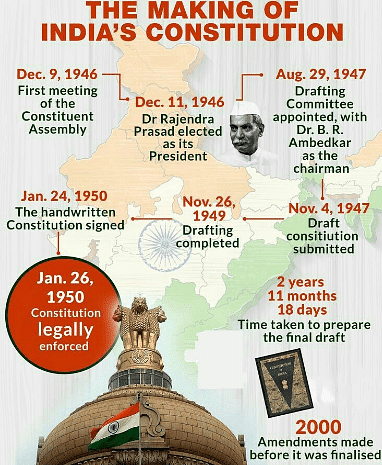
- In March 1942, they sent Sir Stafford Cripps (Cripps mission) a member of the cabinet with a draft declaration of the proposals of the British government which was to be adopted at the end of the war provided that:
(i) The Constitution of India was to be framed by an elected constituent Assembly of the Indian people.
(ii) India would be given Dominion status.
(iii) There should be one Indian Union comprising all the provinces and Indian states but any province which was not prepared to accept the constitution would be free to retain its constitutional position. - Both Congress and Muslim League rejected it and Muslim League urged that India should be divided into two autonomous states into communal lines and there should be a separate Constituent Assembly to build Pakistan.
- After it, a Cabinet mission was sent who put forward his own proposals on 16 May 1946. The broad features of the scheme were:
(i) There would be a union of India comprising both British India and the States.
(ii) The Union would have an Executive and a legislature constituted of representatives of the provinces and States.
(iii) The proposal also contained a plan to elect constituent Assembly by indirect elections, to frame the constitution. - For forming the Constituent Assembly election were held which were joined by the Muslims League. On 9th December 1946, the first meeting of the Constituent Assembly was held which was not attended by the Muslim League and the assembly began to function without the Muslim members. The Muslim league urged for the dissolution of the constituent assembly on the ground that it was not fully representative of all sections of the people of India.
- On the other hand, the British government on 20th Feb 1947 declared-that British rule in India would in any case end by 30th June 1948.
- Then Lord Mountbatten succeeded Lord Wavell as Governor-general. He brought the Congress and Muslim league into an agreement that the two problem provinces of Punjab and Bengal would be partitioned to form absolute Hindu and Muslim majority blocks within the provinces which were derived by cabinet mission and the league would get its Pakistan. The actual decision of partition of the two provinces was left to the vote of the members of the legislative Assemblies of these provinces. It was also proposed that there would be a referendum in the N.W.F.P and in the Muslim majority districts of Sylhet as to whether they would join India or Pakistan.
- On 26th July 1947, the Governor-general announced the setting of a separate constituent assembly for Pakistan. On the basis of the above plan, the British government passed the Indian Independence Act, 1947, which provided that from 15 August 1947 in place of India there would be set up two independent Dominions to be known as India and Pakistan and gave unlimited power to the constituent assembly of each dominion to frame and adopt any constitution and to repeat any act of the British Parliament including the India Independence Act. So the constituent assembly was reassembled on 14 August 1947 as the sovereign Constituent Assembly of the dominion of India. It had been elected by indirect election by the members of the provincial legislative Assemblies to elect 292 members while the Indian states were allotted a maximum of 93 seats.
- As a result of partition under the plan of June 3rd, 1947, the representative of Bengal, Punjab, Sind, N.W.F.P, Baluchistan, and Sylhet district of Assam ceased to members of the Constituent Assembly of India and there was a fresh election in new provinces of West Bengal and East Punjab. So the membership of the House was reduced to 299. Of these 284 were actually present on 26th November 1949 and signed the constitution finally.
- The Drafting Committee was appointed on 29th August 1947 with B.R Ambedkar as its chairman with six other members which were N.Gopalswami Ayyangar, Alladi Krishnaswamy Ayyar, K.M.Munshi, Mohd. Sadullah, B.L.Mittar (replaced by N.Madhav Rao), D.P.Kaithan (died in 1948 and replaced by T.T.Krishnamachari).
- The Draft Constitution of India was published in Feb 1948, the assembly next met in Nov. 1948 to consider the provisions of the Draft. The second reading was completed by the 17th October 1949 and third on 14th November 1949.On the 26th November 1949, on which date the constitution received the signature of the President of the Assembly and was declared PASSED.
- According to Article 394, provisions relating to the citizenship elections, provisional Parliament and temporary and transitional provisions contained in Articles 5, 6, 7, 8, 9, 60,324,366,367,379,380,388,391, 392, and 393 came into force on the day of adoption (i.e. 26 November 1949) of the Constitution and the remaining provisions of the Constitution came into being on the day of the commencement (i.e. 26 January 1950) of the Constitution. According to Article 395, the Government of India Act of 1935 and the Indian Independence Act of 1947 got replaced with the commencement of the Constitution of India.
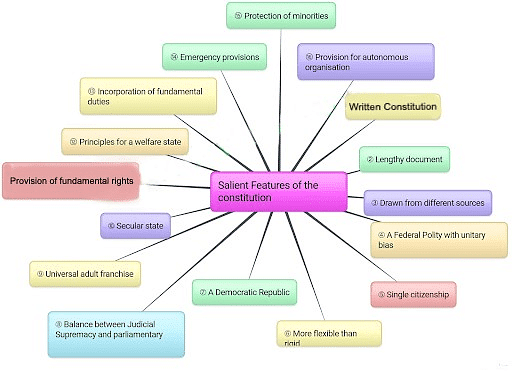
➢ Written, Lengthy and Detailed Constitution
- Our Constitution is written, lengthy, and detailed. Written constitution is that which is based on written laws duly passed by a representative body elected for this very purpose. In other words, a written constitution is an enacted constitution.
- An unwritten constitution, on the other hand, is an evolved constitution. It is primarily based on unwritten conventions, traditions and practices. The Constitution of the U.S.A. is another example of a written constitution and that of England of an unwritten one.
- The Constitution of India is an elaborate document and is the most voluminous Constitution in the world. Our Constitution originally consisted of 395 Articles and eight Schedules. During the last fifty eight years of its operation, ninety four Amendments have been made to the Constitution. Four new Schedules have also been added, resulting in a further increase in its size and volume.
- An important reason for the extraordinary volume of the Constitution is that it contains detailed provisions regarding numerous aspects of governance. This was done to minimize confusion and ambiguity in the interpretation of the Constitution, another reason for its unusual lengthy is the incorporation of the good points of various constitutions of the world.
- The vastness of our country and its peculiar problems has also added to the bulk of the Constitution. Thus, for example, the Indian Constitution envisages laws for the governance of the States too.
- Detailed provisions regarding the working of the Union Government and the State Governments have been given with a view to avoiding any constitutional problem which the newly-born Democratic Republic might experience in the working of the Constitution.
➢ Partly Rigid and Partly Flexible Constitution
- A flexible constitution is that which can be amended like an ordinary law of the country, i.e. by a simple majority of Parliament. On the other hand, a rigid constitution is the one that prescribes a difficult procedure for its own amendment.
- The Constitution of the U.S.A. is the best example of rigid constitution because it can be amended only if a proposal for constitutional amendment is passed by a two-third majority in each House of the Congress (the US Parliament) and ratified by at least three-fourths of the federating states.
- The Constitution of Great Britain, on the other hand, is highly flexible. This is so because it can be amended by a simple majority of its Parliament, much like the ordinary laws of the country.
- The Indian Constitution is neither very flexible nor very rigid. Some provisions of the Constitution can be amended by a simple majority of Parliament, like ordinary laws of the land while most of the provisions can only be amended by a two-thirds majority of Parliament.
- For very important provisions of the Constitution, such as the manner of election of the President and the extent of the legislative powers of the Union and the States, an amendment passed by a two-thirds majority of Parliament should also be ratified by at least one-half of the State legislatures.
- The Indian Constitution thus combines the flexibility of the British Constitution and the rigidity of the American Constitution. Jawaharlal Nehru, while justifying this nature of the Constitution, said, "0ur Constitution is to be as solid and permanent as we can make it, yet there is no permanence in a constitution. There should be a certain amount of flexibility. If you make anything rigid and permanent, you stop the nation's growth, the growth of a living vital organic people."
➢ Partly Federal and Partly Unitary
- Our Constitution declares India a Union of States (federation). It prescribes a dual set of governments-the Union Government and the State Governments.
- The subjects of administration have also been classified into three lists-the Union List, the State List and the Concurrent List. Whereas subjects of national importance like currency, defense, railways, post and telegraph, foreign affairs, citizenship, survey and census have been assigned to the Union Government and placed under the Union List.
- Subjects of local importance like agriculture, law and order, health and entertainment have been assigned to the States and form a part of the State List.
- Both the Union Government and the State Governments operate within the spheres of their authority. The Union Parliament and the State Legislatures enjoy co-equal powers to make laws in regard to the Concurrent subjects. These subjects are of common importance such as marriage and divorce, adoption, succession, transfer of property, preventive detention, education, civil and criminal law, etc.
- However, if there is a conflict between a Union law and a law passed by one or many State Legislatures, the law made by the Union Parliament would prevail over the State law.
- The Indian Constitution possesses other features of a federation too, for example, supremacy of the constitution. This means that the Union and the State Governments both operate within the limits set by the Constitution. Both the governments derive authority from the Constitution itself.
- Similarly, in all federal countries, the authority of the Court is a well established fact. This means that in case of a dispute between the Union Government and State Governments or between two or more State Governments, the verdict of the Court will be final. Not only this, the Supreme Court is given the responsibility of interpreting the Constitution in case of dispute or confusion. The Supreme Court of India is the guardian of the Constitution and fulfils its role as a Federal Court too.
- The Indian Constitution, though federal in form, has a strong unitary bias. The Central Government possesses extensive powers compared to the State Governments. The exercise of these powers by the Centre gives the Constitution the strength of a unitary government. Let us look at those provisions of the Indian Constitution that make it partly unitary. The Union Government can supersede the authority of the States both in the normal and abnormal times. The President of India can declare three different types of emergencies. During the operation of an emergency, the powers of the State Governments are greatly curtailed and the Union Government becomes all in all.
- Even in normal times, the Union Parliament can legislate upon a subject given in the State List, if the Rajya Sabha passes a resolution by a two-thirds vote that such legislation is necessary in the national interest.
- Moreover, the Indian Constitution, unlike the US Constitution, does not provide for double citizenship, division of public services or of the judiciary.
- Similarly, the States in India do not enjoy the right to secede from the Union nor do they enjoy equality of representation in the Council of States (Rajya Sabha).
- Another unitary feature of our Constitution is that it gives Union Parliament the power to alter the boundaries of the existing States or to carve out new States out of the existing ones. It is on account of these features that the Indian Constitution is said to be federal in form but unitary in spirit.
Influence of Other Constitutions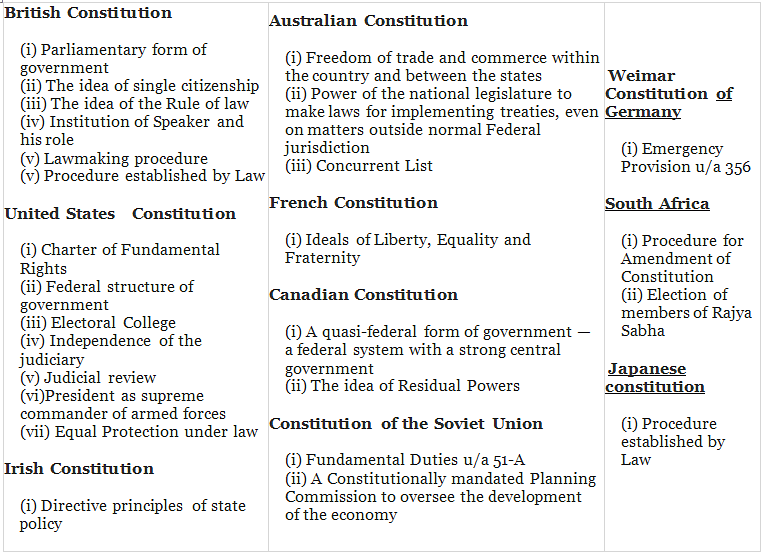
- The Preamble to the Constitution sets out the main objectives which the Constituent Assembly intended to achieve.
- The 'Objective Resolution', proposed by Pandit Nehru and passed by the Constituent Assembly, ultimately became the Preamble to the Constitution of India.
- The Constitution (42nd Amendment) Act, 1976 amended the Preamble and added the words Socialist, Secular, and Integrity to the Preamble.
- The Preamble is non-justiciable in nature, like the Directive Principles of State Policy, and cannot be enforced in a court of law.
- It can neither provide substantive power (definite and real power) to the three organs of the State, nor limit their powers under the provisions of the Constitution.
- The Preamble cannot override the specific provisions of the Constitution. In case of any conflict between the two, the latter shall prevail. So, it has a very limited role to play.
➢ Purposes of the Preamble
- The Preamble declares that it is the people of India who had enacted, adopted, and given the Constitution to themselves. Thus, sovereignty lies ultimately with the people.
- It also declares the ideals and aspirations of the people that need to be achieved.
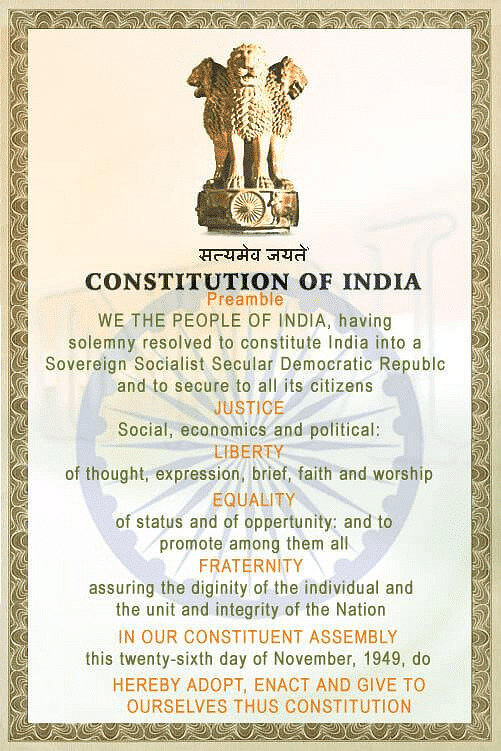
➢ Sovereign
- The word 'Sovereign' emphasizes that there is no authority outside India on which the country is in any way dependent.
➢ Socialist
- By the word 'Socialist', the Constitution means the achievement of a socialistic pattern of society through democratic means.
➢ Secular
- India is a 'Secular State' does not mean that India is non-religious or irreligious, or anti-religious, but simply that the State in itself is not religious and follows the ancient Indian principle of "Sarva Dharma Samabhava".
- It also means that the State shall not discriminate against the citizens in any way on the basis of religion.
➢ Is it a part of the Constitution?
- The Supreme Court in the Kesavananda Bharati vs. State of Kerala (1971) case overruled its earlier decision (Berubari case) of 1960 and made it clear that it is a part of the Constitution and is subject to the amending power of the Parliament as any other provisions of the Constitution, provided the basic structure of the Constitution as found in the Preamble is not destroyed. However, it is not an essential part of the Constitution.
- In the latest S.R. Bommai case, 1993 regarding the dismissal of three BJP Governments in MP, Rajasthan and Himachal Pradesh, Justice Ramaswamy said, "the Preamble of the Constitution is an integral part of the Constitution. A democratic form of government, federal structure, unity, and integrity of the nation, secularism, socialism, social justice, and judicial review are basic features of the Constitution".
- The question arises as to why Preamble was amended when it is a basic feature. By the 42nd amendment, the Preamble was amended to include 'socialist',' secular', and 'integrity' as it was assumed that these amendments are clarifying and qualifying in nature. They are already implicit in the Preamble.
➢ Democratic
- The term 'Democratic' means that the rulers are elected by the people, and they only have the authority to run the government.
The word 'Republic' means that there exists no hereditary ruler in India and all the Authorities of the State are directly or indirectly elected by the people.
➢ Justice: social, economic, and political
- Regarding justice, one thing is clear that the Indian Constitution expects political justice to be the means to achieve social and economic justice, by making the State more and more welfare-oriented in nature.
- Political justice in India is guaranteed by universal adult suffrage without any sort of qualification.
- While social justice is ensured by abolishing any title of honor (Art. 18)
and untouchability (Art. 17), economic justice is guaranteed primarily through the Directive Principles.
➢ Liberty: of thought, expression, belief, faith, and worship
- Liberty is an essential attribute of a free society that helps in the fullest development of the intellectual, mental, and spiritual faculties of an individual.
- The Indian Constitution guarantees six democratic freedoms to individuals under Art 19 and the Right to freedom of religion under Arts 25-28.
➢ Equality: of status, opportunity
- The fruits of liberty cannot be fully realized until there is an equality of status and opportunity.
- Our Constitution makes it illegal, any discrimination by the State only on the basis of religion, caste, sex, or place of birth (Art. 15) by throwing open public places to all, by abolishing untouchability (Art. 17) and by abolishing titles of honor (Art 18).
- However, to bring the hitherto neglected sections of the society into the national mainstream, the Parliament has passed certain laws for the SCs, STs, OBCs (Protective Discrimination).
➢ Fraternity
- Fraternity as enshrined in the Constitution means a sense of brotherhood prevailing amongst all the sections of the people. This is sought to be achieved by making the State secular, guaranteeing fundamental and other rights equally to people of all sections, and protecting their interests. However, fraternity is an evolving process and by the 42nd amendment, the word 'integrity' was added, thus giving it a broader meaning.
- KM Munshi termed it as 'the Political Horoscope'. Earnest Barker calls it the 'key to the Constitution'. Thakurdas Bhargava recognized it as the 'Soul of the Constitution'.
- The term 'Socialistic pattern of society' was adopted as a goal of the Indian State by the Congress in 1955 in Avadi Session.
Indian constitution consists of 22 parts, 395 articles, and 12 Schedules (initially 8 schedules were there) which are as follow:
- Part I - Union and its Territory
- Part II - Citizenship.
- Part III - Fundamental Rights.
- Part IV - Directive Principles and Fundamental Duties.
- Part V - The Union.
- Part VI - The States.
- Part VII - States in the B part of the First schedule.
- Part VIII - The Union Territories
- Part IX - Panchayat system and Municipalities.
- Part X - The scheduled and Tribal Areas
- Part XI - Relations between the Union and the States.
- Part XII - Finance, Property, Contracts, and Suits
- Part XIII - Trade and Commerce within the territory of India
- Part XIV - Services Under the Union, the States, and Tribunals
- Part XV - Elections
- Part XVI - Special Provisions Relating to certain Classes.
- Part XVII - Languages
- Part XVIII - Emergency Provisions
- Part XIX - Miscellaneous
- Part XX - Amendment of the Constitution
- Part XXI - Temporary, Transitional and Special Provisions
- Part XXII Short title, date of commencement, Authoritative text in Hindi, and Repeals.
There are 12 Schedules in the Indian Constitution. Schedules can be added to the constitution by amendment.
- States and Union Territories;
- Emoluments for High-Level Officials;
- relates to different forms of Oaths;
- Allocation of the number of seats in the Rajya Sabha (Council of States - the upper house of Parliament) per State or Union Territory;
- Provisions for the administration and control of Scheduled Areas and Scheduled Tribes;
- Provisions for the administration of tribal areas in Assam, Meghalaya, Tripura, and Mizoram;
- Relates to three types of lists: The Union (central government), State, and Concurrent (dual) lists;
- The Official Languages Recognised under the constitution ( There are 22 languages in this schedule; English is not mentioned in this schedule).
- Article 31B-Validity excluded from Court’s Review (land and tenure reforms; the association of Sikkim with India). It was added by the 1st Constitution Amendment Act in 1951. It is the largest schedule of the constitution.
- Anti-Defection provisions for Members of Parliament and Members of the State Legislatures (added by 52nd Constitution Amendment Act in 1985).
- It relates to functions of Panchayats (Rural Development); added by the 73rd Constitution Amendment Act in 1992.
- It relates to functions of Municipalities (Urban Planning); added by Constitution Amendment Act in 1992.







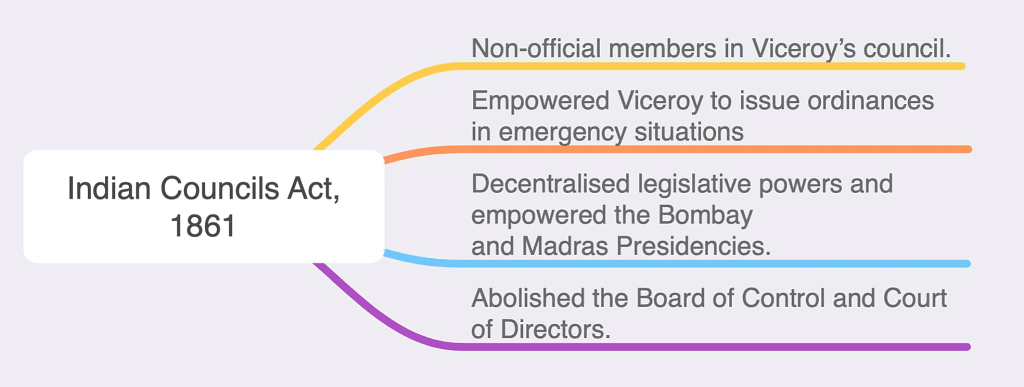


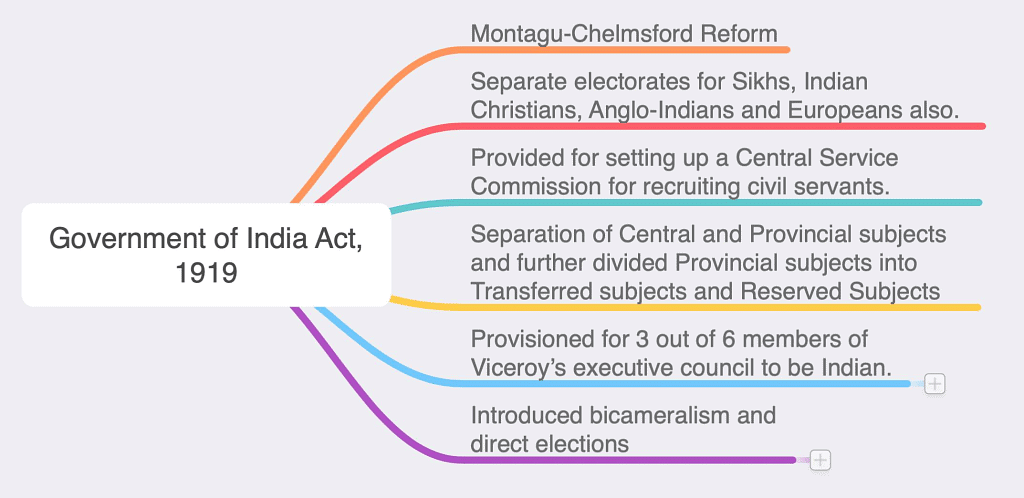

 M.N. Roy, the first person to put forward the idea of the Constituent Assembly
M.N. Roy, the first person to put forward the idea of the Constituent Assembly
- M.N. Roy first time kept forward the idea of the Constituent Assembly in 1934.
- In 1935, the Indian National Congress for the first time demanded a Constituent Assembly to frame the Constitution of India.
- In 1938 Jawahar Lal Nehru declared that the Constitution of free India must be framed by a Constituent Assembly whose members are to be elected based on an adult franchise. It should be free from any external interference.
- In the 1940s 'August Offer' demand got accepted and in 1942 Sir Stafford Cripps was sent to India with a draft proposal on the framing of an independent Constitution to be adopted after World War II.
- Muslim league rejected the proposal as it demanded two dominion states with two separate constituent assemblies.
- Later in 1946, the Cabinet mission put forward the idea of a Constituent Assembly which satisfied both the INC and the Muslim League.
- In November 1946, Constituent Assembly was constituted under the scheme formulated by the Cabinet Mission Plan.

 Constituent AssemblyThe Cabinet Mission Plan provisioned the following scheme for setting up the Constituent Assembly of India:
Constituent AssemblyThe Cabinet Mission Plan provisioned the following scheme for setting up the Constituent Assembly of India:
- The total strength of the Constituent Assembly was 389. Of these, 296 seats were allotted to British India and 93 seats to the Princely States. Out of 296 seats allotted to British India, 292 members were drawn from the eleven governors’ provinces and 4 from the four chief commissioners’ provinces, and one from each.
- Each province and princely state were to be allotted seats in proportion to their respective population. Roughly one seat was to be allotted for every million population.
- Seats allocated to each British province were to be divided among Muslims, Sikhs, and General (others), in proportion to their population.
- The representatives of each community were to be elected by members of that community in the provincial legislative assembly and voting was to be by the method of proportional representation using a single transferable vote.
- The representatives of the princely states were to be nominated by the heads of the princely states.
Thus, under the above provisions, the Constituent Assembly became a partly elected and partly nominated body. The members were indirectly elected by the members of the provincial assemblies. It did not present the sentiments of the masses as the members of provincial assemblies themselves were elected on a limited franchise.
- The election for 296 seats allotted to the British Indian Provinces was held in July-August 1946. Out of these seats, Indian National Congress won 208 seats, the Muslim League won 73 seats, and the remaining 15 seats were held by independent players.
- 93 seats allocated to princely states were not filled as they refrained from the Assembly.
- Though the assembly did not reflect the mass verdict it had representatives from every section of the society.
- Mahatma Gandhi was not a member of the Constituent Assembly.
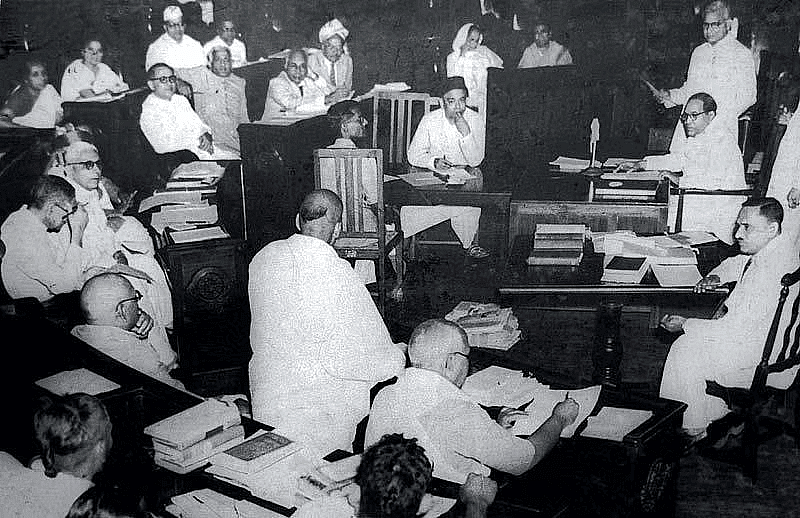
The Constituent Assembly held its first meeting on December 9, 1946. Muslim League boycotted the meeting and demanded a separate state of Pakistan. Only 211 members attended the first meeting.
Dr. Sachchidananda Sinha was elected as the temporary/interim President of the Assembly, following the French practice. Later Dr. Rajendra Prasad was elected as the President of the Assembly and both H.C. Mukherjee and V.T. Krishnamachari became the Vice-President of the Assembly.
Objective Resolution: On December 13, 1946, Jawahar Lal Nehru moved the ‘Objective Resolution’ in the Constituent Assembly which was unanimously adopted by the assembly on January 22, 1947.
- This Constituent Assembly declares it's firm and solemn resolve to proclaim India as the Independent Sovereign Republic and to draw up for her future governance a Constitution.
- Wherein the territories comprising present times British India, the territories that now form the Indian State and such other parts of India as are outside India and the States as well as other territories as are willing to be constituted into independent sovereign India, shall be a Union of them all
- Wherein the said territories, whether with their present boundaries or with such others as may be determined by the Constituent Assembly and thereafter according to the law of the Constitution, shall possess and retain with the residuary powers and exercise all powers and functions of the Government and administration implied in the Union or resulting therefrom
- Wherein all power and authority of Sovereign Independent India, its constituent parts and organs of Government are derived from the people.
- Wherein shall be guaranteed and secured to all the people of India justice, social, economic, and political; equality of status of opportunity, and before the law; freedom of thought, expression, belief, faith, worship, vocation, association, and action, subject to the law and public morality.
- Wherein adequate safeguards shall be provided for minorities, backward and tribal areas, and depressed and other backward classes.
- Whereby shall be maintained the integrity of the territory of the Republic and its sovereign rights on land, sea, and air according to justice and the law of civilized nations.
- This ancient land attains its rightful and honored place in the world and makes its full and willing contribution to the promotion of world peace and the welfare of mankind.
Initially, the representatives of the princely states stayed away from the Constituent Assembly. On April 28, 1947 representatives of the 6 states became part of the assembly and after the acceptance of the Mountbatten Plan of June 3, 1947, most of the other princely states entered the assembly. Later the members of the Muslim League from the Indian dominion also joined the assembly.
Changes after the Indian Independence Act, 1947: The act of 1947 made the following changes:
- The Assembly became the fully sovereign body and was empowered to frame any Constitution it pleased.
- It became the legislative body. It became responsible to frame the Constitution of India and enact ordinary laws for the country. Whenever the assembly worked as the Constitutional body, it was chaired by Dr. Rajendra Prasad and when it met as a legislative body, G.V. Mavlankar became the chairman (this arrangement continued till November 26, 1949).
- Muslim League withdrew from the assembly and it reduced the total strength of the assembly to 299 from 389. The strength of Indian provinces reduced to 229 from 296 and that of princely states to 70 from 93.
Other Functions performed by the Assembly:
- Ratified India’s membership of the Commonwealth in May 1949.
- Adopted the National Flag of India on July 22, 1947.
- Adopted National Anthem on January 24, 1950.
- Elected Dr. Rajendra Prasad as the first President of India on January 24, 1950.
On January 24, 1950, the Constituent Assembly held its final session but continued as the provincial parliament from January 26, 1950, till the first general elections in 1951-52 were held.

Drafting Committee
On August 29, 1947, a Drafting Committee was set up to prepare a draft of the new Constitution. It was a seven-member committee with Dr. B.R. Ambedkar as the Chairman of the committee. Other 6 members include:
Members of the Drafting Committee
- N. Gopalaswamy Ayyangar
- Alladi Krishnaswamy Ayyar
- Dr. K.M. Munshi
- Syed Mohammad Saadullah
- N.M. Rau
- T.T. Krishnamachari
The first draft prepared by the committee was published in February 1948. The second draft was published in October 1948.
- Dr. B.R. Ambedkar introduced the final draft of the Constitution in the Assembly on November 4, 1948, for the first reading. The second reading was held on November 15, 1948, and the third reading on November 14, 1949.
- The draft was passed on November 26, 1949 (thus, celebrated as the Constitution day).
- The Constitution as adopted on November 26, 1949, contained Preamble, 395 Articles, and 8 Schedules.



- Provisions of citizenship, elections, provisional parliament, temporary and transitional provisions, and short title are contained in Articles 5, 6, 7, 8, 9, 60, 324, 366, 367, 379, 380, 388, 391, 392, and 393 came into force on November 26, 1949. The remaining provisions came into force on January 26, 1950.
- With the adoption of the Constitution, all the provisions under the Indian Independence Act, 1947, and the Government of India Act, 1935 were repealed.
- The Abolition of Privy Council Jurisdiction Act (1949) continued.
The Constituent Assembly was criticized on various grounds including:
- Not a Representative Body as it did not reflect the mass verdict due to election by the limited franchise.
- Not a Sovereign body as it was formed based on the proposals of the British Government and held its meeting with their permission.
- Took greater time in framing the Constitution as compared to the American constitution which took only 4 months.
- Dominated by Congress
- Domination of Lawyers and Politicians and representation of other professionals was not significant
- Dominated by Hindus
Do You Know!
- S.N. Mukherjee was the chief draftsman of the constitution in the Constituent Assembly.
- Prem Behari Narain Raizada was the calligrapher of the Indian Constitution. He had handwritten the original text of the constitution in a flowing italic style.
- It was beautified and decorated by artists from Shanti Niketan including Nand Lal Bose and Beohar Rammanohar Sinha.
- The calligraphy of the Hindi version of the original constitution was done by Vasant Krishan Vaidya and decorated and illuminated by Nand Lal Bose.
- The elephant was adopted as the symbol of the Constituent Assembly. Thus, its figurine was carved on the seal of the assembly.
- Originally, the Constitution of India did not make any provision concerning an authoritative text of the Constitution in the Hindi Language. Later, a provision in this regard was made by the 58th Constitutional Amendment Act of 1987 which inserted a new Article 394-A in the last part of the constitution.
In this document you have learnt that
- In 1935, the Indian National Congress for the first time demanded a Constituent Assembly to frame the Constitution of India.
- In November 1946, Constituent Assembly was constituted under the scheme formulated by the Cabinet Mission Plan.
- Muslim League withdrew from the assembly and it reduced the total strength of the assembly to 299 from 389. The strength of Indian provinces reduced to 229 from 296 and that of princely states to 70 from 93.
- Members of the Drafting Committee
- N. Gopalaswamy Ayyangar
- Alladi Krishnaswamy Ayyar
- Dr. K.M. Munshi
- Syed Mohammad Saadullah
- N.M. Rau
- T.T. Krishnamachari
- One of the main criticism of The Assembly was it being a domination of Lawyers and Politicians and representation of other professionals was not significant.
CRIPPS MISSION
Within the next two years, however, a dramatic change in the British attitude had taken place. This was due to two reasons.
(i) The British forces had suffered disastrous defeats in different theatres of War
(ii) The international situation became so unfavourable to Britain, with Japan almost at the doorstep of the Indian empire, that she had to seek the support of the popular forces in India.
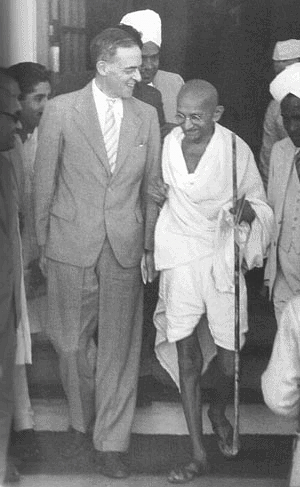 Cripps and Mahatma Gandhi during the Second World War
Cripps and Mahatma Gandhi during the Second World War
The Cripps Mission wanted the Indian leaders to support and work wholeheartedly for the prosecution of the War and envisaged complete transfer of power to Indians after the War.
Negotiations, however, failed. The Indian National Congress demanded complete Indianisation of the Governor General's Executive Council. But the British rulers were not prepared to surrender the portfolio of Defence to the Indians. Gandhiji called the proposals as a postdated cheque.
The failure of the Cripps Mission led to acute discontent in India. It exposed the intentions of the British rulers.
On August 8, 1942, the All India Congress Committee passed the famous "Quit India" resolution for the immediate ending of the British rule and sanctioned "the starting of a mass struggle on nonviolent lines on the widest possible scale."
It was Gandhiji who piloted the resolution in the Congress Committee.
Wavell Plan
Another abortive effort to solve the political deadlock in Indian was made in 1945. Lord Wavell invited the leaders of all sections of political opinion. A conference was held at Shimla. The Wavel plan in its essence was the complete Indianisation of the Executive Council. The caste Hindus and Muslims were to be represented on the basis of parity.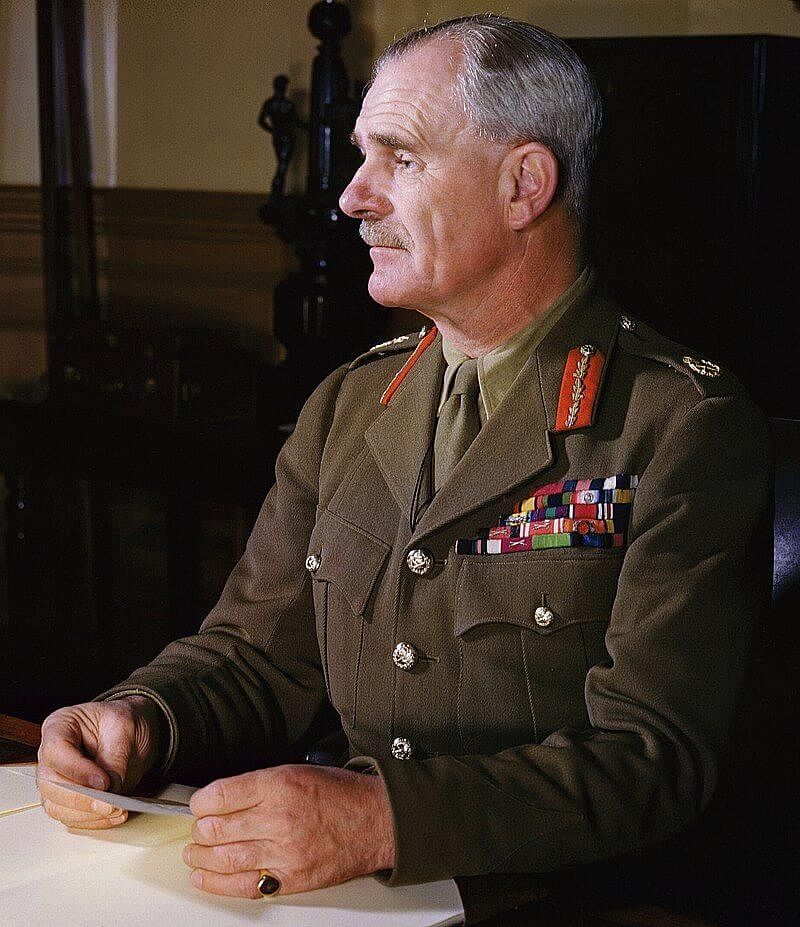 Sir Archibald Wavell
Sir Archibald Wavell
The Congress, being a national organisation, insisted on the nomination of its representatives from all the communities. The conference met with failure because neither the Congress nor the League was prepared to deviate from the stand taken by them.
Cabinet Mission Plan
- The Labour Party which came to power after World War II, wanted to transfer power to the Indians as a matter of political expediency.
- A mission consisting of three Cabinet Ministers of the British government–Sir Stafford Cripps, Lord Penthic Lawrence and A.V. Alexander– was, therefore, sent to India to resolve the political deadlock. They announced their plan regarding the future political set up of India, known as the Cabinet Mission Plan.
- The plan rejected the demand of the All India Muslim League for partition of the country and establishment of a fully sovereign Pakistan. It envisaged a confederation consisting of three groups of autonomous states vesting the powers of three departments– Defence, External Affairs and Communications– in a Central government and all the remaining powers with the groups themselves.
- Each of the groups was free to have a separate constitution of its own choice, thus giving ample scope for both the leading religious groups– Hindus and Muslims– to enjoy complete autonomy in areas where they were in a majority.
- The plan had two parts, namely, a long-term programme and a short-term one. While the former was concerned with the future political setup on a permanent basis, the latter was intended to establish an immediate Indian government.
- The Muslim League accepted both parts of the plan while the Indian National Congress decided that it would unreservedly accept only the long-term programme. As a result, the Muslim League later on rejected the plan as a whole and declared that it would resort to direct action to achieve its own demands.
- Meanwhile, elections in the British Indian provinces were completed and the provincial autonomy scheme of the Constitution Act of 1935 was given effect to by forming popular ministries in all provinces. But the question of forming an interim cabinet at the Centre still remained unresolved.
- As a temporary measure, a caretaker government of senior civil service officials was formed by the Governor-General towards the end of June 1946.
After the elections to the Central and provincial legislatures and the Constituent Assembly in June 1946 Lord Wavell invited Jawaharlal Nehru in August 1946 to consider proposals for the formation of an interim government at the Centre. - An interim government was formed on September 2, 1946. The Muslim League at first refused to join it but later on, it did so. It, however, continued to boycott the Constituent Assembly.
- A ticklish situation was created due to the Muslim League's participation in the interim government and non-participation in the Constituent Assembly. An attempt to establish the practice of collective responsibility in the interim government failed on account of the hostile attitude of the Muslim League.
- Ultimately, the Muslim League withdrew from the interim government and demanded the dissolution of the Constituent Assembly of India on the ground that it was not fully representing all sections of the Indian people.
- It was on February 20, 1947 that British Prime Minister Clement Attlee announced that the British government was determined to transfer power to responsible Indian hands and fixed June 1948 as the final date for the purpose. If within that period Indian leaders fail to produce an agreed solution, the Britishers would not stay in after that date and would hand over power to one or more than one government.
- For the purpose of taking necessary steps for transfer of power, the British Government thought that Lord Wavell was not fit and, therefore, the appointment of Lord Wavell was terminated and Lord Louis Mountbatten as appointed to succeed him was the Governor-General.
- Mountbatten Plan
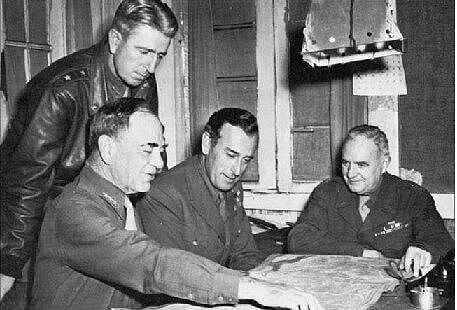 Lord Mountbatten while proposing his plan
Lord Mountbatten while proposing his plan
- On February 20, 1947, the British government made a historic announcement declaring its intention to transfer power to responsible Indian hands not later than June 1948. Lord Mountbatten, immediately after assumption of office, plunged himself into prolonged negotiations with party leaders.
- With a view to facilitating this transfer, and at the same time to accommodate the rival claims of the two leading communities, he devised the plan of partition of the country into India and Pakistan. Creation of Pakistan was assented to by both the parties and on June 25, 1947, Lord Mountbatten made the announcement of the agreed plan.
- According to this plan, Punjab and the Bengal provinces were partitioned between the two new nations. People of the NWFP and the Sylhet district of Assam were given the right to decide through plebiscite whether they wished to join Pakistan or India. Boundary Commissions were to be set up for partitioning the provinces concerned.
- The old Constituent Assembly minus the Muslim League members was to carry on its work of framing the Constitution of India, and Pakistan was to have a separate Constituent Assembly. August 15, 1947 instead of June 1948, was fixed as the final date for transfer of power.
Indian Independence Act, 1947
As a result of the acceptance of the Mountbatten plan, the Indian Independence Act, 1947 was passed by the British Parliament on July 18, 1947. The main provisions of this Act are as follows:
(i) New dominions– The Act set up two dominions– India and Pakistan– from August 1947. Article 2 of the Act determined the territories of the two Dominions.
The Pakistan Dominion was to consist of Baluchistan, Sindh, West Punjab, N.W.F.P., and East Bengal, including the Sylhet district of Assam. The remaining
parts of British India were to constitute the Indian Dominion.
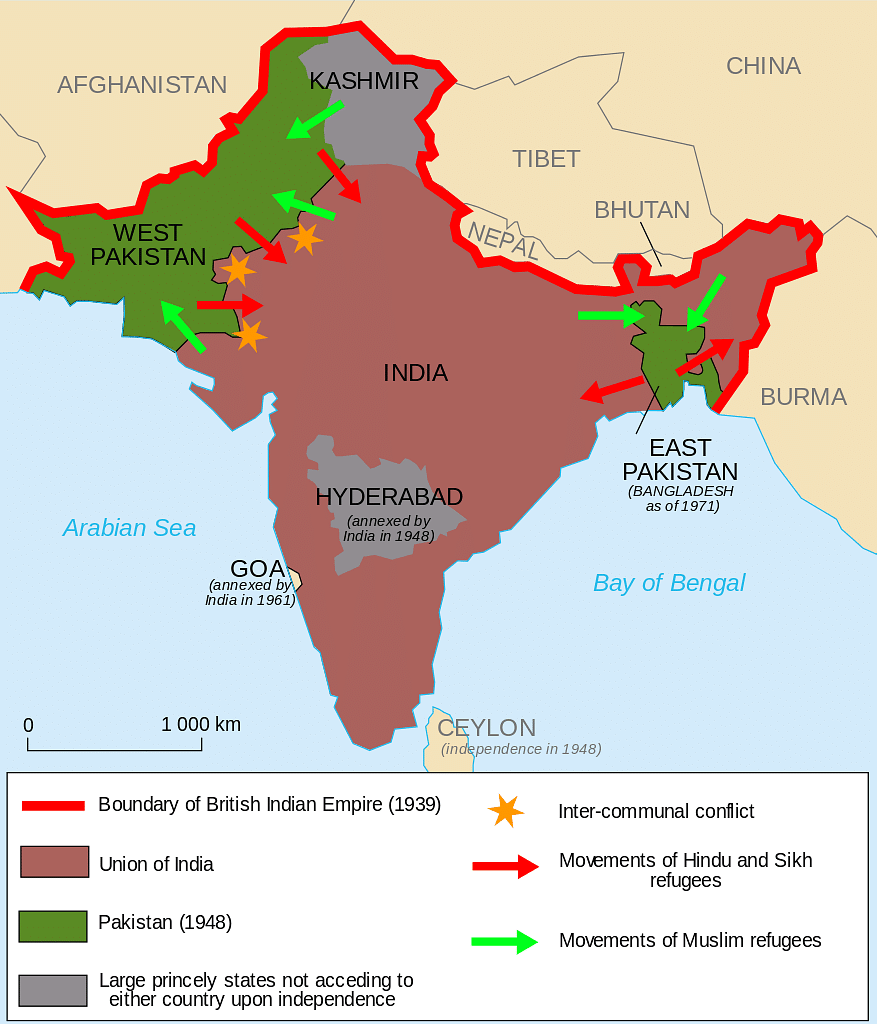 India and Pakistan at the time independence (Indian independence act, 1947)Note that the territory of the two States was significantly altered by the accession of the Princely States
India and Pakistan at the time independence (Indian independence act, 1947)Note that the territory of the two States was significantly altered by the accession of the Princely States
The fate of N.W.F.P., whether it was to join Pakistan or not, was to be decided by a referendum before August 15, 1947. Similarly, a referendum was to
be held in the Sylhet district of Assam.
(ii) Governor-General– The Act provided that for each Dominion, "there shall be a Governor-General to be appointed by His Majesty for the purpose of the governance of the Dominion." The same person, unless the Legislature of each of these Dominions passed a law otherwise, could be a Governor-General of both the Dominions.
(iii) Legislatures– Until a new Constitution was framed for each Dominion, the Act made the existing Constituent Assemblies the Dominion legislatures for the time being. The Dominion legislatures were given full powers to make laws for their Dominions.
(iv) Temporary Provisions as to the Government of each Dominion– The Constituent Assembly of each Dominion was to act as Legislature of that Dominion. It was also to exercise powers for framing the Constitution of the Dominion.
Except in so far as the Constituent Assembly enacted laws, each dominion was to be governed so far as possible in accordance with the Government of India Act, 1935. However, discretionary and individual judgement powers of the Governor-General and Governors under that Act were to lapse.
(v) Indian States– The sovereignty of the British Crown over the Indian States lapsed with effect from August 15, 1947. Along with this, the treaties and agreements between his Majesty and the Indian States also lapsed. The States thus became sovereign entities. The States were given the freedom, if they so wished, to join India or Pakistan, or to remain as independent entities.
(vi) Tribal Areas– As in the case of Indian States, the treaties and agreements between His Majesty and any person having authority in the tribal areas lapsed; and so did the obligations, rights and functions of His Majesty under such agreements and treaties.
(vii) Abolition of the Office of Secretary of State for India– The office of the Secretary of State for India and his advisory board were abolished and instead the Secretary of Commonwealth Relations was to handle matters between the dominions and Great Britain.
(viii) British Monarch was no longer Emperor of India– The title Emperor of India was deleted from the Royal style of the British Monarch.
(ix) Miscellaneous– The other provisions of the Act dealt with the Civil Services, the Armed Forces, the British Forces in India, etc. The rights and privileges of the Civil Services were protected. Provision was made for division of Armed Forces and retention of the authority and jurisdiction of His Majesty over the British Forces stationed on the territories of India and Pakistan.
Parliamentary Terms
- Question Hour- The day’s business normally begins with the Question Hour during which questions asked by the members are answered by the Ministers.
- Starred Question is one for which an oral answer is required to be given by the Minister on the floor of the House. Supplementary questions may be asked based on the Minister’s reply. The Speaker decides if a question should be answered orally or otherwise. One member can ask only one starred question on a day.
- Unstarred Question is one for which the Minister lays on the table a written answer. A 10-day notice has to be given to ask such questions and no supplementary questions can be asked with regard to such questions.
- Short Notice Question can be asked by members on matters of public importance of an urgent nature. It is for the Speaker to decide whether the matter is of urgent nature or not. The member has also to state reasons for asking the question while serving notice.
- Zero Hour- This period follows the Question Hour and it generally begins at noon. Usually the time is used by members to raise various issues for discussion.
- Cut Motions- A motion that seeks reduction in the amount of a demand presented by the government is known as a cut motion. Such motions are admitted at the Speaker’s discretion. It is a device through which members can draw the attention of the government to a specific grievance or problem.
- Calling Attention Motion- A member may, with prior permission of the Speaker, call the attention of a Minister to any matter of urgent public importance and the Minister may make a brief statement regarding the matter or ask for time to make a statement.
CONSTITUENT ASSEMBLY
- Indian Constitution was framed by a Constituent Assembly. As early as in 1922 Mahatma Gandhi put forward the demand that India's Constitution should
be devised by the Indians themselves.Constituent assembly
- The demand for the establishment of a Constituent Assembly was first embodied in a resolution of the Indian National Congress passed at its Faizpur session on December 8, 1936.
- The same demand was further raised by the provincial legislatures where Congress had a majority. But this was all onesided. The British rulers were not yet prepared to entertain the demand. It was during World War II and under the stress of international conditions that Sir Stafford Cripps was sent over to India to win over the support of Indian political leaders.
- The proposals of Sir Cripps contained provisions for setting up a body for preparing the Constitution of India after the termination of the War. The proposals of Sir Cripps were not accepted by the Indian political parties. Later in 1946, the Cabinet Mission came to India and put up a proposal for the setting up of a Constituent Assembly.
- The proposals were accepted by the major political parties in India. Members of the Constituent Assembly were elected by indirect election by the members of the Provincial Legislative Assemblies (Lower House only), according to the scheme recommended by the Cabinet Delegation.
The essentials of this scheme were:
(i) Each province and each Indian State or group of States were allotted the total number of seats proportional to their respective population roughly in the ratio of one to a million. The Constituent Assembly thus created had 389 members in all, including 93 representatives of the India States.
(ii) The seats in each province were distributed among the three main communities, Muslim, Sikh and General, in proportion to their respective population.
(iii) Members of each community in the Provincial Legislative Assembly elected their own representatives by the method of proportional representation with single transferable vote.
(iv) The method of selection in the case of representatives of Indian States was to be determined by consultation.
Sovereign body
The Constituent Assembly, as established in 1946 according to the Cabinet Mission Plan, was not a sovereign body. Its authority was limited both in respect of the basic principles and procedure. According to the Indian Independence Act of 1947, the Constituent Assembly became a sovereign body and all other limitations imposed upon it under the Cabinet Mission Plan were lifted.
Working of Constituent Assembly
The first meeting of the Constituent Assembly was held on December 9, 1946 under the chairmanship of Dr. Sachidanand Sinha, the eldest member of the Assembly. On December 11, 1946, Dr. Rajendra Prasad was elected its permanent Chairman. The Muslim League boycotted it. The work of the Constituent Assembly was seriously handicapped.
The situation in the country deteriorated seriously. Communal riots broke out throughout the country and the whole situation culminated in the sad partitioning of the country in accordance with the Mountbatten Plan of June 3, 1947.
The Constituent Assembly minus the Muslim League members re-started the work. The Constituent Assembly of India then consisted of about 300 members, including the representatives of the states acceding to India.
The method which the Constituent Assembly adopted was to lay down first its objectives. This was done in the form of an "Objective Resolution" moved by Pandit Jawaharlal Nehru on December 13, 1946.The objectives of the Constituent Assembly were :
(i) India was to be an independent sovereign republic in which both British India and the princely states were to be included.
(ii) Each unit was to be given a certain amount of autonomy as well as residuary powers.
(iii) All authority and powers of the States were to be derived from the people who were to be guaranteed freedom of economic and political justice, equality of status, and equality before the law. They were to be guaranteed freedom of thought, vocation, association, expression, belief, faith, worship and action subject to law and morality.
(iv) The minorities and backward and tribal people were to be provided adequate safeguards. Between December 9, 1946 and August 14, 1947, five sessions of the Constituent Assembly were held. In accordance with Indian Independence Act, of 1947, the Constituent Assembly became a sovereign body. It was no longer to confine itself to the limitations laid down by the Cabinet Mission. On August 29, 1947, the Assembly set up a Drafting Committee to consider the draft constitution. The Committee consisted of eminent constitutionalists like Dr. B.R. Ambedkar (Chairman), Sir Alladi Krishnaswami Ayyar, N. Gopalaswami Ayyangar, Syed Mohammad Saadullah, T.T. Krishnamachari, K.M. Munshi, and Sir B.L. Mittar who was on 5, December 1947 replaced by N. Madhava Rao Dr. Rajendra Prasad was elected President of the Assembly.
Commencement of the Constitution
The Constitution received the signature of the President of the Constituent Assembly on 26 November 1949 and was declared as passed. The provisions relating to citizenship, elections, provisional Parliament, temporary and transitional provisions were given immediate effect. The rest of the Constitution came into effect on 26 January 1950 and this date is referred to in the Constitution as the date of its commencement. The original Constitution is a voluminous document containing 395 Articles and eight Schedules. A number of other Articles and Schedules were added by some constitutional amendments made thereto after its promulgation.
Features Adopted From Different Constitutions
The Indian Constitution-makers tried to adopt the best features from the important Constitutions of the world. Mainly, we have adopted features of the Constitutions of the United Kingdom, the United States of America, Canada, Ireland, etc.
Following are the main influences of these Constitutions:
British Constitution: We have adopted the following features of the Constitution of the United Kingdom:
(i) The office of the President of India is based upon that of the British Queen who is the nominal head of the state.
(ii) The Cabinet system of government in India is based upon the Cabinet system as prevailing in the United Kingdom.
(iii) Our Prime Minister is also a replica of the British Prime Minister.
(iv) Just like the United Kingdom, our Parliament is also bicameral, i.e., it has two Houses, the Lower House and the Upper House.
(v) The Lok Sabha, the Lower House of Parliament of India, is as powerful as the House of Commons.
(vi) As in the United Kingdom, the Council of Ministers is mainly responsible to the Lower House, i.e., the Lok Sabha.
(vii) Like the United Kingdom, the presiding officer of the Lok Sabha is also known as the Speaker. Some of his powers resemble those of the Speaker
of the House of Commons in U.K.
(viii) The privileges of members of Parliament in India are also based upon their counterparts in the United Kingdom.
American Constitution: Following features of our Constitution have been adopted from the American Constitution:
(i) Our Constitution is a written one like that of the United States.
(ii) The federal system of government in India influenced by the American Constitution.
(iii) The fundamental rights in our Constitution are inspired by the American Constitution.
(iv) Like the American head of state our head of state is also known as President.
(v) Like the American Constitution we have also made a provision for a Supreme Court of India.
(vi) Our provinces are known as States after the American State under the Constitution of the United States.
(vii) Just like the Senate of the United States the Rajya Sabha in India also represents the States.
Constitution of Canada: From Canada, we have adopted the scheme of the federation. Influenced by the Constitution of Canada, India is also known as a "Union of States" and not as "United State of India" as is the case with the United States of America.
Constitution of Ireland: From Ireland, we have adopted the concept of Directive Principles of State Policy. Ireland itself had borrowed the principle from the Republican Constitution of Spain.
Fig: Borrowed features of Indian constitutionAlthough our Constitution-makers borrowed these provisions from many foreign Constitutions, they have tried to make the Indian Constitution a document which is most suitable to the Indian conditions and environment. According to Jawaharlal Nehru, "in any event, whatever system of government we may establish here must fit in with the temper of our people and be acceptable to them."
Important amendment 7th, 42nd, 44th, 73rd, 74th and 97th Amendments. In fact, the 42nd Amendment Act (1976) is known as the "Mini-Constitution' due to the important and large number of changes made by it in various parts of the Constitution. However, in the Kesavananda Bharati easel (1973), the Supreme Court ruled that the constituent power of Parliament under Article 368 does not enable it to alter the "basic structure' of the.
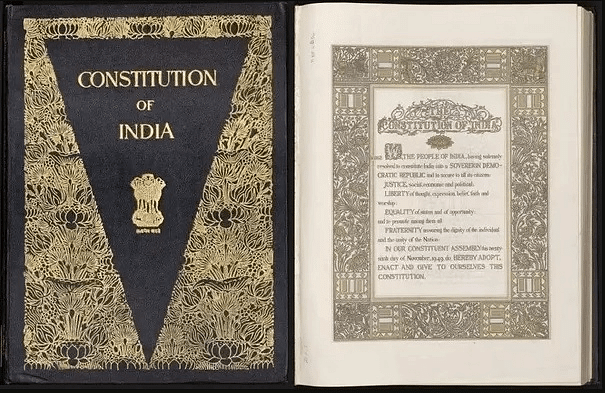 Indian Constitution
Indian Constitution
It is the lengthiest constitution in the world. Originally (1949), the Constitution contained a Preamble, 395 Articles (divided into 22 Parts) and 8 Schedules. Presently (2016), it consists of a Preamble, about 465 Articles (divided into 25 Parts) and 12 Schedules.
Dr B R Ambedkar proudly acclaimed that the Constitution of India has been framed after ransacking all the known Constitutions of the World'. The structural part of the Constitution is, to a large extent, derived from the Government of India Act of 1935.
The Constitution of India is neither rigid nor flexible but a synthesis of both. Article 368 provides for two types of amendments:
- Some provisions can be amended by a special majority of the Parliament, i.e., a two-thirds majority of the members of each House present and voting, and a majority (that is, more than 50 per cent), of the total membership of each House.
- Some other provisions can be amended by a special majority of the Parliament and with the ratification by half of the total states.
- The Constitution of India establishes a federal system of government. It contains all the usual features of a federation, viz., two government, a division of powers, a written Constitution, the supremacy of the Constitution, the rigidity of the Constitution, independent judiciary and bicameralism.
- The Indian Constitution also contains a large number of unitary or non-federal features, viz., a strong Centre, single Constitution, single citizenship, flexibility of Constitution, integrated judiciary,
- The Indian Constitution has been variously described as federal in form but unitary in spirit’, "quasi-federal by KC Where, "bargaining federalism’ by Morris Jones, co-operative federalism’ by Granville Austin, ‘federation with a centralising tendency’ by Ivor Jennings, and so on.
The parliamentary system is based on the principle of cooperation and coordination between the legislative and executive organs while the presidential system is based on the doctrine of separation of powers between the two organs. The parliamentary system is also known as the 'Westminster model of government, responsible government and cabinet government. The Constitution establishes the parliamentary system not only at the Centre but also in the states. The features of parliamentary government in India are:
- Presence of nominal and real executives;
- Majority party rule, Collective responsibility of the executive to the legislature,
- Membership of the ministers in the legislature
- Leadership of the prime minister or the chief minister,
- Dissolution of the Lower House (Lok Sabha or Assembly).
- The doctrine of the sovereignty of Parliament is associated with the British Parliament while the principle of judicial supremacy with that of the American Supreme Court.
- Just as the Indian parliamentary system differs from the British system, the scope of judicial review power of the Supreme Court in India is narrower than that of what exists in the US. This is because the American Constitution provides for 'due process of law' against that of procedure established by law' contained in the Indian Constitution (Article 21).
- Therefore, the framers of the Indian Constitution have preferred a proper synthesis between the British principle of parliamentary sovereignty and the American principle of judicial supremacy.
- The Indian Constitution establishes a judicial system that is integrated as well as independent.
- The Supreme Court stands at the top of the integrated judicial system in the country. Below it, there are high courts at the state level.
- Under a high court, there is a hierarchy of subordinate courts, that is, district courts and other lower courts.
- The Supreme Court is a federal court, the highest court of appeal, the guarantor of the fundamental rights of the citizens and the guardian of the Constitution.
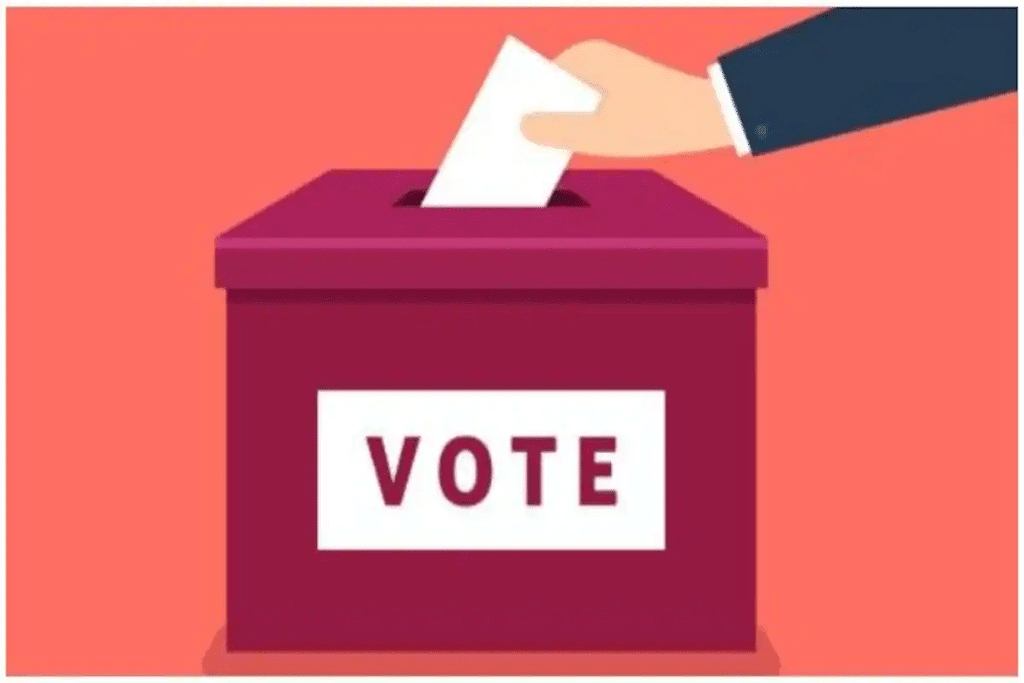 Universal Adult Franchise
Universal Adult Franchise
- The Indian Constitution adopts universal adult franchise as a basis of elections to the Lok Sabha and the state legislative assemblies. Every citizen who is not less than 18 years of age has a right to vote without any discrimination of caste, race, religion, sex, literacy, wealth, and so on. The voting age was reduced to 18 years from 21 years in 1989 by the 61st Constitutional Amendment Act of 1988.
- Universal adult franchise makes democracy broad-based, enhances the self-respect and prestige of the common people, upholds the principle of equality, enables minorities to protect their interests and opens up new hopes and vistas for weaker sections.
Fundamental Rights.
A secular State covered in the Preamble chapter.
Independent bodies covered in the Constitutional bodies chapter.
Emergency Provision, Singh Citizenship.
DPSP, Fundamental Duties, Three-tier Government.
INTRODUCTION
Our constitution has adopted the best features of most of the major constitutions of the world as per the needs of the country. The parliamentary system of democracy has been taken from Britain, the concept of federalism from the USA, the idea of directive principles from Ireland, and a few more features from the constitutions of Australia and Canada. Our constitution is federal in structure but with unitary features. It is a lengthy and legalistic document, but reasonably flexible. This article lists the 13 major features of the constitution and comprehensively covers each of the features in the article.
Constitution of India – Major Features
The 13 Major features of the Indian constitution are listed below
1. Popular Sovereignty
2. Rule Of Law
3. Judicial Review
4. Socialism
5. Secularism In Indian Constitution
6. Fundamental Rights
7. Directive Principles Of State Policy
8.Fundamental Duties
9. Judicial Independence
10. Parliamentary System
11. Federal And Unitary Features
12. Lengthy And Legalistic Document
13. Flexibility Of The Constitution
14. Single Citizenship
15. Emergency Provisions
1. Popular Sovereignty
The constitution proclaims the sovereignty of the people in its opening itself. The idea is reaffirmed in several places in the Constitution, particularly in the chapter dealing with elections. Article 326 declares that “the elections to the House of People and the Legislative Assembly of every state shall be on the basis of adult suffrage”. As a result, the Government at the Centre and in the States derive their authority from the people who choose their representatives for Parliament and the State Legislatures at regular intervals. Further, those who wield the executive power of the government are responsible to the legislature and through them to the people. Thus, in the affairs of the State, it is the will of the people that prevails ultimately and not the will of a few selfish individuals. This is the principle of popular sovereignty.
In spite of the ignorance and illiteracy of large sections of the Indian people, the Constitution Assembly adopted the principle of the adult franchise with faith in the common man and the ultimate success of democratic rule. The Assembly was of the opinion that democratic government on the basis of adult suffrage would alone “bring enlightenment and promote well-being.”
Free elections are, perhaps, the greatest forum of mass education. The dangers inherent in adult suffrage among illiterate peoples can be mitigated only by the blessings of universal education. In a country like India, the large majority of whose population is illiterate, the attainment of universal education is a goal still a long way off. But this need not necessarily mean that until a certain minimum standard of universal education is realised, the Indian masses are incapable of properly exercising their right of franchise. Illiteracy is not quite the same thing as ignorance. A free election, which ensures the free exchange of ideas and free canvassing by contending parties who stand for different programs of social organization for the realisation of the common welfare, offers the best medium for the political education of the illiterate masses. It is this that the constitution guarantees. The constitution-makers were not satisfied by merely providing for adult suffrage. They wanted to ensure free elections by creating an independent constitutional authority to be in charge of everything connected with elections. The free election is a reality in India. It ensures for the electors both the freedom of choice and the secrecy of the ballot. The general elections have demonstrated that the ordinary man, in spite of his so-called ignorance, has been able to exercise his robust common sense in electing candidates of his choice. Neither money nor social status nor official position has been powerful enough to make him a convenient tool in the hands of a few is itself guarantee that popular sovereignty will remain a living reality in India despite the fact that most of its people are steeped in ignorance, poverty and social backwardness.
All that the constitution provides is that every adult citizen of India shall have the right to vote. This becomes significant when viewed in the background that for quite a long time, the women in many parts of Europe did not enjoy any such right. In addition, under the Government of India Act, 1935, hardly 15 per cent of Indian citizens had this right. According to some thinkers, this is the boldest step which has been taken by our constitution fathers. This shows that they had full faith in the capacity of the people of India to use their right properly. Some critics of course felt that it was premature to give to the people of India this right when there were poverty and illiteracy and the masses were yet politically not mature. But constitution fathers took a bold step and resolved to go ahead and wanted to make a beginning in this direction right earnestly.
The principle of popular sovereignty has not been a mere ideal embodied in the constitution but has been a living reality during about five decades through which the Constitution has been in operation. The previous right in the hands of the citizen which ensures the democratic ideal of “one man, one vote, one value”, irrespective of his wealth, education, social status and “importance”, has, in fact, enhanced their self-respect as citizens of a democratic India
Rule Of Law
According to this axiom, people are ruled by law but not by men, that is, the basic truism that no man is infallible. The axiom is vital to a democracy.
More important is the meaning that law is the sovereign in democracy. The chief ingredient of law is custom which is nothing but the habitual practices and beliefs of common people over a long number of years. In the final analysis, rule of law means the sovereignty of the common man’s collective wisdom. Apart from this crucial meaning, rule of law means a few more things like (a) there is no room for arbitrariness (b) each individual enjoys some fundamental rights, and (c) the highest judiciary is the final authority in maintaining the sanctity of the law of the land.
It is this spirit that is making us make various efforts to make Article 14 (all are equal before the law and all enjoy equal protection of laws) meaningful, like providing legal assistance to the needy, promotion of Lok Adalats and the venture of the Supreme court known as “public interest litigation”. Also, as per today’s law of the land, any litigant can appeal to the presiding judicial authority to argue the case by himself or seek legal assistance with the help of the judiciary.
Judicial Review
The right of the judiciary to review executive acts and legal enactments where there they are not in conformity with the established law of the land and its procedures is known as judicial review. Based on this principle the American Supreme court has acquired the power to so interpret the Constitution that it has come to be known as the third chamber of the Constitutions, whereas, in India, our Supreme court does not enjoy the power of adding to the Constitution but it can only strike down any, act or any, legislation on the ground that it is contrary to the basic framework of the constitution or violative of the procedure established by law.
As the constitution stands today, the judiciary in India has the right to review legislative enactments and executive acts provided they are brought before the courts except for a few specific acts like the discretionary powers of the governors, the privileges and immunities of the members of the legislatures, etc. In pronouncing its verdict on legislative acts and executive actions the Supreme Court primarily bases itself on what is known as the basic framework of the Constitution-a phrase which has never been spelt out so that others could know the ingredients that go into the making of the basic framework of the Constitution. However, it is clear from the constitution as it is today that the Parliament has the right to amend the constitution as long as it does not erode the basic framework of the constitution. Thus, making additions or deleting some Articles of the constitution is the power of the Parliament but not that of the Supreme Court as in the case of the U.S.
Socialism
Increasing intervention, as well as participation by the State in the economic field, has been a distinguishing feature of the twentieth century. There is hardly any country today in which the State is not actively engaged in a variety of economic activities. In varying degrees, governments everywhere are involved in economic, industrial, commercial management. This is broadly described as the influence of socialist ideas on State activity.
Even before the adoption of a new Constitution, the Government of independent India had made clear its policy to enter the economic field in a very active manner. The Industrial Policy Resolution of 1948 gives ample evidence of this. It envisaged a greater role for the State in the economic development of the country. Certain industries such as atomic energy, manufacturing of arms and ammunition were declared to be the sole monopoly of the State. The right of the State to nationalise any major industry and bring it within the public sector was also clearly stated.
The Directive Principles of State Policy, however, unmistakably set out the socialist objective of the Constitution, although one might point out that they do not go far enough to establish a full-fledged socialist order. But then, it is also clear that our conception with its emphasis on a set of guaranteed fundamental rights did not envisage collectivist socialist State like those that existed in Eastern Europe during 1945 and 1990. On the contrary, it aims to establish a democratic socialist state which while moving progressively towards the social ideal, wants at the same time to protect and preserve basic human rights.
Nevertheless, successive amendments to the Constitution clearly show that the direction is more towards the realisation of socialist than the democratic ideal. The constitution was amended several times with a view to realising this objective. Among those amendments, special mention may be made of the First, Fourth, Seventeenth, Twenty-fifth, Twenty-ninth, Thirty-fourth and Forty-second Amendments. Almost every one of these give precedent to the Directive Principles over Fundamental Rights in the implementation of certain legislative enactments. The Forty second Amendment (1976) went a step further and amended the permeable of the Constitution to include specifically the term “socialist” which was absent in the original form in which it was enacted.
Secularism In Indian Constitution
India has declared its identity as a “Sovereign, Socialist, Secular Democratic Republic.” The attributes of Socialist and Secular were added in 1976 by the 42nd Amendment to the Constitution. The bulky document does not attempt to define secularism. However, a definition is derived from the fundamental right that proclaims that “The State shall not discriminate against any citizen on grounds of religion, race, caste, sex place of birth or any one of them. “The Indian State has no religion of its own. The fundamental right of speech and freedom also means the right to preaching and proselytising religion. This is made clearer in Articles 25—28, “Subject to public order, mortality and health… all persons are equally entitled to freedom of conscience and the right to profess, practice and propagate religion”. The wearing and carrying of kirpans (swords) shall be deemed to be included in the freedom of the Sikh religion. Every religious denomination or any section thereof shall have the right to establish and maintain institutions for religious and charitable purposes, to maintain its own affairs in matters of religion. No person shall be compelled to pay any taxes for promotion of any particular religion. No religious instructions shall be provided in any educational institutions wholly maintained out of the State funds.”
The distinguishing features of a secular democracy as contemplated by the Constitution of India are: (i) that the State will not identify itself with or be controlled by any religion; (ii) that while the State guarantees to everyone the right to profess whatever religion one chooses to follow (which includes also the right to be an antagonist or an atheist), it will not accord preferential treatment to any of them; (iii) that no discrimination will be shown by the State against any person on account of his religion or faith; and (iv) that the right of every citizen, subject to any general condition, to enter any office under the state will be equal to that of the fellow citizens. Political equality which entitles any Indian citizen to seek the highest office under the State is the heart and soul of secularism as envisaged by Constitution.
The conception aims to establish a secular state. This does not mean that the State in India is anti-religious. Secularism in its original, historical sense was an anti-God and anti-religious concept. But in the Indian context, that concept has no relevance.
Fundamental Rights
The constitution contains the basic principle that every individual is entitled to enjoy certain rights as a human being and the enjoyment of such rights does not depend upon the will of any majority or minority. No majority has the right to abrogate such rights. In fact, the legitimacy of the majority to rule is derived from the existence of these rights. These rights include all the basic liberties such as freedom of speech, movement and association, equality before the law and equal protection of laws, freedom of religious belief and cultural and educational freedoms.
The constitution has classified these rights into seven categories and one of them is the right to constitutional remedies which entitles every aggrieved person to approach even the Supreme Court of India to restore to him any fundamental right that may have been violated. It is, thus, a basic affirmation of the Constitution that the political system that it establishes should provide conditions favourable for the maximum development of the individual’s personality. The framers of the Constitution were conscious of the fact that in the absence of the enjoyment of the above-mentioned rights, such development of the personality was impossible and democracy would sound an empty word. Having spent most of their lives under a foreign rule and having fought relentlessly for the enjoyment of these rights by themselves, it was only natural that they should have wanted to embody them in the Constitution they framed for the establishment of a democratic political order. They hoped to build this political order on the firm foundation of the freedom of political competition. The prime importance of these rights is that while the will of the majority decides how these freedoms are to be implemented, the existence of the freedoms themselves is not subject to that will. On the contrary, these freedoms set the conditions under which the will of the majority is to be formed and exercised.
Directive Principles Of State Policy
It is for the first time in India’s Constitution, a chapter on Directive Principles of the State Policy has been included. Before it, in the Government of India Act, 1935, there was no Instrument of Instructions for the Governor-General, but it was quite different from the present Directives. These Directives are a guideline for the governments, but their violation cannot be challenged in the court of law. According to few critics when the Directive has no legal binding, these are useless. But that is not so. These are the manifestation of our aims and aspirations. The government of the day can choose to violate these but if the people take the violation seriously they can throw the government out of power. The greatest force behind these Directives is the will of people. The Directives are guidelines both for the people as well as the government. These save us from duping in the dark. Thus these principles are not mere precepts but a great moral force.
The wall of separation which the fundamental rights erect between the government and the people is indeed one of the greatest and surest safeguards of the life, liberty and the pursuit of happiness of the individual. But conditions of absolute and unhindered growth of private power, like absolute governmental power, are capable of destroying individual freedom. The concentration of private power, mainly in the form of economic controls, in the hands of a few individuals is equally destructive of the dynamic qualities of a democratic society as a dictatorial government could be. In a highly capitalist society, a few giants in the industrial and financial world, who concentrate in themselves the bulk of economic power, can easily subject the rest of the community to the travails of a new feudalistic order. After having provided against the emergence of a totalitarian system through the constitutional guarantees of fundamental rights, the framers turned their attention to deal with the possible future menace of a private capitalist concentration of economic power and to ensure the establishment and sustenance of a society which provided for the diffusion of economic power among the different sections of the people. The methods they sought to provide for the purpose are embodied in the chapter on Directive Principles of State Policy. The State and every one of its agencies are commended to follow certain fundamental principles while they frame their policies regarding the various state activity. These principles, on the one hand, are assurances to the people as to what they can expect from the State and, on the other, are directives to the Government, Central and State.
Fundamental Duties
Originally Fundamental Duties were not there in the constitution. It was a great lacuna of the constitution. Hence the Swaran Singh Government was appointed which recommended 12 Fundamental Duties. However, out of that 10 Fundamental Duties were accepted by the 42nd Amendment of the constitution. But at present, one more fundamental duty has been added under the 86th Amendment Act, 2002. There are total of 11 Fundamental duties altogether.
Now in their modified form, the Fundamental Duties are as follows:
- To abide by the constitution and respect the national flag and the national anthem.
- To cherish the noble ideals which inspired our struggle for freedom.
- To uphold the sovereignty, unity and integrity of the country.
- To defend the country and render national service when called on to do so.
- To promote harmony and the spirit of common brotherhood among all the people of India.
- To value and preserve the rich heritage of our composite culture.
- To protect and improve the natural environment includes lakes, rivers and Wildlife and have compassion for the living.
- To develop the scientific temper, humanism and “the spirit of inquiry and reform.
- To safeguard. Public property and abjure violence.
- To strive to achieve excellence in all spheres of individual and collective life so that the nation makes progress.
- to provide opportunities for education to his child or ward between the age of six and fourteen years.
Judicial Independence
Man’s long struggle has been to live under a government of laws, not of men. Equal justice under the law has for long been his cherished ideal, a system under which the new law is applicable to all alike. Man has in all ages been striving to escape the regime that dispenses justice according to the political or religious ideology of the litigant or the whim or caprice of those who run the government. As a consequence of this struggle, there was an established principle of abiding value, that no judiciary can be impartial unless it is independent. In fact, the judicial process ceases to be judicial the moment those who seek to judge cease to be independent of every form of external influence. Hence the importance of judicial independence.
Parliamentary System
The framers of our Constitution preferred a parliamentary system of government. Our infant democracy could ill-afford any confrontation between the executive and the legislature if they were separate and independent of each other. The President of India is the constitutional head of the Union Executive, but he exercises the executive power, vested in him, in accordance with the advice of the Union Council of Ministers. The real executive power thus vests with the Council of Ministers with the Prime Minister as the head. The Council of Ministers is collectively responsible to the Lok Sabha. The same is true of the relationship between the Governors and the Council of Ministers in the States.
The parliamentary system of government both at the Centre and in the State is based on adult suffrage whereby all citizens of India who are not less than 18 years of age and not otherwise disqualified by the Constitution or any law, have the right to vote. It is a bold political experiment in view of the vastness of the country, its large population, poverty and illiteracy.
Federal And Unitary Features
The word ‘federation’ has not been used anywhere in the Constitution. In fact, India has been described as a Union of States. The provinces and the princely States were not sovereign entities before they joined the federation. The states are not ‘inviolable’ or ‘indestructible’ as in the USA. Parliament can by law change or alter the areas and boundaries of any State. No state has the right to secede from the Union.
But, it has some basic federal features. India has two governments functioning at the national and state levels with a clear cut distribution of powers. Both the State and the Union Government draw their authority from the Constitution. The supremacy of the Republic lies not with either the Union Government or the State Governments but with the Constitution. To uphold the legal supremacy of the Constitution, the power to interpret the constitution has been vested in the judiciary. Thus the Indian Constitution has four federal features: (a) clear division of powers between the two governments; (b) dual system of government; (c) supremacy of the Constitution; and (d) authority of the judiciary to interpret the constitution.
All the constituent States of the Union are not equal. The Union Territory do not enjoy the same status as the States. Unlike the American Constitution, the Indian Constitution does not provide for any safeguards for the protection of the rights of States. Except for Jammu & Kashmir, no state has its own Constitution as in the U.S. Whereas the consent of the States is vital for an amendment of the American Constitution, the consent of the States in India is necessary only in regard to a few specific matters.
There are some features in our Constitution unlike the U.S.:
- The right of the Governor to reserve a Bill for Presidential assent;
- The role and functions of the State Governors;
- The Emergency provisions of the Constitution regarding the proclamation of national emergency, financial emergency and President’s rule;
- Provisions of the Constitution enabling Parliament to legislate for the States;
- Uniform All-India Services;
- Single and uniform citizenship; and
- Uniform and integrated judicial system.
Also, the constitutional schemes of distribution of legislative, administrative and financial powers between the Union and the States have a strong unitary bias, unlike the US where the Federal Government has gained more powers through the interpretation of its Supreme Court.
Lengthy And Legalistic Document
It is the most lengthy and legalistic constitutional document any country has so far adopted. One reason is that the Constitution has drawn from a variety of sources. The other is that the constitution-makers ensured that no element of uncertainty was left. It codifies in detail the relationship between the Union and the States and the State’s interests and contains both justiciable and non-justiciable rights as well as fundamental duties. As the Constitution is not only a legal document but an instrument of social change, it has to be a detailed document in order to ensure that it stands the test of any situation in future. Also, care has been taken to ensure that the Constitution is not subverted or perverted by any future government. There are numerous in-built constitutional safeguards.
There are temporary, transitional and special provisions for the state of Jammu and Kashmir and it also takes care of the regional problems in States like Gujarat, Maharashtra, Andhra Pradesh, Sikkim, Assam, Nagaland and Manipur. The legalistic nature of the Constitution is also partly because of heavy borrowings from the Government of India Act of 1935.
Flexibility Of The Constitution
Some eminent lawmakers are of the view that the constitution is rigid. But, we know that it has been possible to amend the constitution over a hundred times. Our constitution is more flexible than the American constitution. In our constitution only amending of a few provisions requires ratification by half of the State Legislatures. While most of the provisions of the Constitution can be amended by a two-thirds majority of each of the Houses of Parliament and many of the provisions can be altered or modified by a simple majority. Also, the constitution can be supplemented by simple legislation like the Citizenship Act, National Security Act, the Untouchability Act etc.
Moreover, the scope for the growth of conventions to supplement the constitution makes it more flexible. Conventions govern the privileges and rights of the legislature, the functioning of the cabinet system, the status of the Cabinet Secretariate, etc.
Single Citizenship
In a federation, there is usually double citizenship. A citizen belongs to the State in which he is born and also enjoys the citizenship rights of the Federation, to which his state has joined as a unit. This is on the basic principle that the states in a federation are of course units, but do not at the same time, give up their individual entity. But in India, there is single citizenship. Citizens belong to the Indian Union and not to any state.
Provision for single citizenship for the whole of India was perhaps intentional. The constitution fathers did not like that regionalism and other disintegrating tendencies which had already raised their ugly heads and were endangering the very security and integrity of the country, should be further encouraged by providing double citizenship. Provision for double citizenship would have naturally stood on the way of emotional and national integration. The people in the State would have thought more in terms of the State than the country as a whole. Single citizenship has undoubtedly forged a sense of unity among the people of India and the image of United India is reflected by this provision.
Emergency Provisions
One of the unique features of the Constitution of India is the way in which situations will be dealt with during an emergency. According to emergency provisions when the head of the State is satisfied that it is impossible to run the administration of the country or a part thereof, in accordance with the normal procedure laid down in the Constitution he can declare an emergency and take administration of the country or part thereof in his own hands. This emergency can be financial or political. Declaration of emergency has far-reaching effects and its consequences are that with such a declaration fundamental rights are suspended and the courts of law can refuse to entertain petitions for the enforcement of these rights. Federal set up of the country practically turns out to be a unitary one and no bill can be introduced in the legislature without prior permission of the head of the states. The President or Governor is the exclusive authority to decide as to whether there are need and necessity of declaration of such an emergency. In India emergency was declared in 1962, when China invaded India. It was again declared in 1965 and 1971 when Pakistan invaded the country. In 1975, an internal emergency was declared in the country, as a result of which censorship of the press was imposed. During this period Forty Second Constitution Amendment Act was passed which introduced far-reaching changes in the Constitution. This emergency was lifted only in 1977.
Provisions in the Constitution dealing with declaration of emergency were amended by Constitution Forty-Fourth Amendment Act by which it was ensured that in future it became difficult for any Prime Minister to declare an internal emergency. On several occasions, the President of India has taken over the administration of states on the plea that there is constitutional break down and administration of the state cannot be run in accordance with the provisions of the constitution. Over the years the salient features of the Indian Constitution have developed clear contours. The federal features of the Constitution have been weakened because certain centralising influence has become more and more compulsive. The Parliamentary executive has become increasingly assertive because one party has dominated the Indian political scene until now with a brief interlude. The chapter on Fundamental Rights has undergone a radical change with the deletion of the “Right to Property”. The role of the judiciary, too, is undergoing changes because of the growing radicalism and needs of social justice. And the Directive Principles, although not justiciable, have almost become as important as the Fundamental Rights. A good number of transitional provisions have been dropped. Finally, the conventions that the country has been evolving are also changing the temper of the constitution. Since all these changes have occurred in less than 50 years, it shows that even an elaborate and complex constitution necessarily calls for changes and adjustments.
Philosophy of Constitution
On January 22, 1947, the Constituent Assembly adopted the Objectives Resolution drafted by Jawaharlal Nehru. The Objectives Resolution contained the fundamental propositions of the Constitution and set forth the political ideas that should guide its deliberations. The main principles of the resolution were :
- That India is to be an independent, sovereign republic;
- That it is to be a democratic union with an equal level of self-government in all the constituent parts;
- That all power and the authority of the Union Government and governments of the constituent parts are derived from the people;
- That the constitution must strive to obtain and guarantee to the people justice-based upon social, economic and political equality, of opportunity and equality before the law;
- That there should be freedom of thought, expression, belief, faith, worship, vocation, association and action;
- That the constitution must provide just rights for minorities, and people from backward and tribal areas, etc. so that they can be equal participants of social, economic and political justice; and
- To frame a constitution which should secure for India, a due place in the community of nations.
The philosophical of a Constitutions consists of the ideals for which the constitution stands and the policies which the Constitution enjoins upon the rulers of the Community to follow. The Constitution of India reflects the impact of our ideology in the following spheres:
(i) Secularism: Secularism is the hallmark of the Indian Constitution. People professing different religions have the freedom of religious worship of their own choice. All the religions have been treated alike. The fact appreciated in India was that all religions love humanity and uphold the truth. All the social reformers and political leaders of modern Indian have advocated religious tolerance, religious freedom and equal respect for all the religions. This very principle has been adopted in the Constitution of India where all religions enjoy equal respect. However, the word ‘secularism’ was nowhere mentioned in the Constitution as adopted in 1949. The word ‘secularism’ has now been added to the Preamble to the Constitution through the 42nd Amendment passed in 1976.
(ii) Democracy: We have borrowed the modern form of democracy from the West. Under this system, democracy means the periodic responsibilities of the Government to go to the people. For this purpose; elections have been held every five-year to elect a Government by the people. However, democracy covers even the economic and social aspects of life. This aspect of democracy is well-reflected in the Directive Principles of State Policy. They are aimed at human welfare, co-operation, international brotherhood and so on.
(iii) Sarvodaya: Sarvodaya refers to the welfare of all. It is different from the welfare of the majority. It seeks to achieve the welfare of all without exception. It is referred to as Ram Rajya. The concept of Sarvodaya was developed by Mahatma Gandhi Acharya Vinoba Bhave and J. Narayan under which the material, spiritual, moral and mental development of everyone is sought to be achieved. The Preamble to the Indian Constitution and the Directive Principles of State Policy represent this ideal.
(iv) Socialism: Socialism is not new to India. Vedanta philosophy has socialism in it. The national struggle for freedom had this aim also in view. Jawaharlal Nehru referred to himself as a socialist and republican. Almost all the parties in India profess to promote democratic socialism. These principles are included in the Directive Principles of State Policy. However, to lay emphasis on this aspect, the word ‘socialism’ was specifically added to the Preamble to the Constitution through the 42nd Amendment.
(v) Humanism: Humanism is a salient feature of Indian ideology. Indian ideology regards the whole of humanity as one big family. It believes in resolving international disputes through mutual negotiations. This is what we find in the Directive Principles of State Policy.
(vi) Decentralization: Decentralization is another aspect of Sarvodaya. Indian has always practised decentralization through the Panchayat system. Mahatma Gandhi also advocated decentralization. It is on this account that he is regarded as a philosophical anarchist. We have introduced the Panchayati Raj system in India to achieve the objective of decentralisation. The concept of cottage industries as laid down in the Directive Principles of State Policy also refers to decentralization.
(vii) Liberalism: Liberalism does not refer to the Western concept of liberalism. It refers, in the Indian context, to self-government, secularism, nationalism, economic reforms, constitutional approach, representative institutions etc. all these concepts were advocated by the modern Indian leaders.
(viii) Mixed Economy: Co-existence is a salient feature of our ideology. Co-existence has manifested itself through a mixed system of economy. In this system, we have allowed both the private and public sectors of the economy to work simultaneously. Large scale and essential industries have been put in the public sector.
(ix) Gandhism: Gandhism represents an ethical and moral India. Gandhi set a new example of fighting foreign rule through non-violence. He taught the importance of non-violence and truth. He advocated untouchability, cottage industry, prohibition, adult education and the uplift of villages. He wanted a society free of exploitation and decentralized in character. All these Gandhian principles have found an honourable place in the Constitution of India.

Comments
Post a Comment